












16 Sula | Interview Publican Quality Meats butcher Rob Levitt returns to the kitchen—but don’t call it a comeback.

Previews of concerts including D2x, Sara Curruchich at LatiNxt, the ARC Music Festival, and Alex Zhang Hungtai at Plantasia
CEO AND PUBLISHER SOLOMON LIEBERMAN
EDITOR IN CHIEF SALEM COLLO-JULIN
MANAGING EDITOR SHEBA WHITE
PRODUCTION MANAGER KIRK WILLIAMSON
SENIOR GRAPHIC DESIGNER AMBER HUFF
THEATER AND DANCE EDITOR KERRY REID
MUSIC EDITOR PHILIP MONTORO
CULTURE EDITOR: FILM, MEDIA, FOOD & DRINK TARYN ALLEN
04 The To-Do Bounce around, BIPOC creators in Pilsen, and more to do in Chicago
25 Comic For artist Ruby Que, spoons are a metaphor for life and for their practice.

26 Q&A Rising director Landree Fleming makes her big-stage debut with Paramount’s Little Shop of Horrors
28 Feature Keeping up with the WGA and SAG-AFTRA strikes
29 Movies of Note Our critics review BAM!, Blue Beetle, and Strays

40 Early Warnings Concerts to have on your radar
40 Gossip Wolf Tim Kinsella and Jenny Pulse release a new fulllength for Kill Rock Stars, and other local music gossip.

06 Galil | First pitch A journey to make ceremonial first pitches reveals connections between Minor League Baseball and alt-weeklies.
FOOD & DRINK
14 Hot dog! Would it be summer or baseball without delicious encased meats?

18 Prout | Dan Bigg A look at the Chicago Recovery Alliance cofounder’s legacy of positive change
22 Mulcahy | Politics Mayor Johnson’s first 100 days
24 Museums An exhibition that explores the politics of transnational connectivity
MUSIC & NIGHTLIFE
30 Chicago Jazz Fest | Overview and full schedule Writer Bill Meyer looks at this year’s lineup.
32 Chicago Jazz Fest | Carter and Freeman A double bill at the festival features titans of the genre.
34 Chicago Jazz Fest | Alexis Lombre The local jazz musician and singer branches out.
41 Savage Love Dan Savage offers advice to a man in a relationship that needs more milestones.
42 Jobs
43 Community
Cripping the Galleries activates rooms at the Art Institute through the lens of disability culture.

Drag performers join Berlin Nightclub employees in protest

Honoring the incarcerated
An exhibition at the Logan Center Gallery details the experience of COVID-19 in prison


CULTURE EDITOR: ART, ARCHITECTURE, BOOKS, LITERARY ARTS KERRY CARDOZA
NEWS EDITOR SHAWN MULCAHY ASSOCIATE EDITOR AND BRANDED CONTENT SPECIALIST JAMIE LUDWIG
DIGITAL EDITOR TYRA NICOLE TRICHE SENIOR WRITERS LEOR GALIL, DEANNA ISAACS, BEN JORAVSKY, MIKE SULA
FEATURES WRITER KATIE PROUT
SOCIAL JUSTICE REPORTER DEBBIE-MARIE BROWN LISTINGS COORDINATOR MICCO CAPORALE SOCIAL MEDIA ENGAGEMENT
ASSOCIATE CHARLI RENKEN
VICE PRESIDENT OF OPERATIONS
ANN SCHOLHAMER
CHIEF DEVELOPMENT OFFICER DIANE PASCAL
VICE PRESIDENT OF PEOPLE AND CULTURE
ALIA GRAHAM
MARKETING PROJECT STRATEGIST SHAWNEE DAY NEWSLETTER ASSOCIATE CHASITY COOPER
DEVELOPMENT ASSOCIATE MICHAEL THOMPSON TECHNOLOGY MANAGER ARTURO ALVAREZ OFFICE MANAGER AND CIRCULATION
DIRECTOR SANDRA KLEIN
DIRECTOR OF CHICAGO INDEPENDENT MEDIA ALLIANCE (CIMA) SAVANNAH HUGUELEY
SENIOR VICE PRESIDENT OF GROWTH AND STRATEGY AMBER NETTLES
VICE PRESIDENT OF SALES AMY MATHENY
SALES TEAM VANESSA FLEMING, WILL ROGERS DIGITAL SALES ASSOCIATE AYANA ROLLING MEDIA SALES ASSOCIATE JILLIAN MUELLER
ADVERTISING
ADS@CHICAGOREADER.COM
TO CONTACT ANY READER EMPLOYEE, EMAIL: (FIRST INITIAL)(LAST NAME) @CHICAGOREADER.COM THIS WEEK ON CHICAGOREADER.COM
CLASSIFIEDS: CLASSIFIEDS.CHICAGOREADER.COM
NATIONAL ADVERTISING VOICE MEDIA GROUP 1-888-278-9866 VMGADVERTISING.COM
JOE LARKIN AND SUE BELAIR
DISTRIBUTION CONCERNS distributionissues@chicagoreader.com
312-392-2970
READER INSTITUTE FOR COMMUNITY JOURNALISM, INC.
PRESIDENT AND CHAIRPERSON EILEEN RHODES TREASURER REESE MARCUSSON SECRETARY KIM L. HUNT DIRECTORS ALISON CUDDY, DANIEL DEVER, MATT DOUBLEDAY, VANESSA FERNANDEZ, TORRENCE GARDNER, ROBERT REITER, CHRISTINA CRAWFORD STEED
READER (ISSN 1096-6919) IS PUBLISHED BIWEEKLY BY THE READER INSTITUTE FOR COMMUNITY JOURNALISM 2930 S. MICHIGAN, SUITE 102 CHICAGO, IL 60616 312-392-2934, CHICAGOREADER.COM
COPYRIGHT © 2023 CHICAGO READER PERIODICAL POSTAGE PAID AT CHICAGO, IL ALL RIGHTS RESERVED. CHICAGO READER, READER, AND REVERSED R: REGISTERED TRADEMARKS ®
feat. DJs Derrick Carter, Michael Serafini, and Garrett David

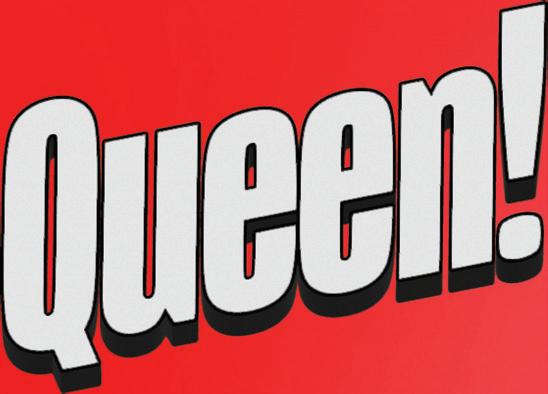

As someone without a car, I do not make a habit of leaving the city, but Bounce the City at Schaumburg’s Woodfield Mall has me reviewing my transit options. From Saturday, August 26, to Monday, September 4, some portion of said suburban outpost will be overtaken by a bizarre, candy-colored, inflatable adventureland. Imagine a bounce house becoming an entire amusement park for you and your friends to enjoy for an hour and a half. Ball pit? Check. Slides? Check. Obstacle courses? Disco dome? Kawaii surrealism? Check, check, and check. The experience only costs $24, and it’s open to all ages—though if you want to take an especially little one, there are “junior sessions” available to those seven and younger (plus their caregivers). bouncethecity.com

Also opening on Saturday, August 26, is Hecho En: Arts & Craft Fair. The fair happens from 10 AM-6 PM both Saturday and Sunday, August 27, outdoors near Pilsen Arts and Community House (1637 W. 18th St.). This event is expansive in nature but centers BIPOC creators, especially those living or working in Pilsen. Makers will share their wares— drawings, photography, plants, candles, and more—along 18th Street between Paulina and Ashland. Not only will there be loads of fun and interesting things to peruse, but there will also be a slate of kid-friendly activities such as bilingual storytelling and button-making. Best of all? It’s free and open to everyone. For a complete list of vendors or schedule of events, check out the fair’s Instagram. instagram.com/hechoen_artsfair
At 4 PM on Sunday, August 27, Mothers of Murdered Transpeople (MOMT) are hosting their annual picnic at Rainbow Beach (2873 E. 75th St.). The group was started by Valerie Griffin in 2018 after her daughter, De’Janay Stanton, was killed. Since then, at least nine transgender and gender nonconforming people have been murdered in Chicago (15 across the country just this year). While the MOMT picnic is an opportunity to commune and honor memories, the
event also seeks to raise awareness of trans experiences and relay that the community can be uniquely vulnerable to violence. Stanton’s sister Chimura Gri n told Block Club she and her mom eventually hope to grow MOMT into a brick-andmortar resource center. The event will begin with a balloon release followed by food, games, and other activities. Everyone is welcome. gofundme.com/f/forever-the-main-event
On Friday, September 1, Heaven Gallery (1550 N. Milwaukee, second floor) hosts an opening reception for the group exhibition “Petrifi ed Wastage.” In the last century, we have become more wasteful, with many technologies developing at an accelerated rate but no plans to deal with the waste. More and more is being designed to break down faster and be replaced sooner. Increasingly, items are made from materials that aren’t biodegradable and can’t be recycled. What becomes of these items? In this show, artists Noah Kashiani, Millicent Kennedy, and Olivia Zubko use mixed media to play with the idea of trash as monuments. It’s an imaginative sort of cultural archaeology that aims to both critique and explore our lives of excess and disposability. While the opening is scheduled for 7-11 PM, the show is on view until October 15. heavengallery.com
Lately, The Front Row screening series has been programming a delightful amount of arty pornography at the Music Box (3733 N. Southport)—but not Labor Day weekend! On Sunday, September 3, they throw a curveball with Burst City, a Japanese movie made in 1982 where rival punk bands compete during a protest of a nuclear power plant that ends up pitting them against the yakuza industrialists trying to destroy their homes. This movie’s got it all: sick music, hot outfi ts, and incredible action . It’s somewhere between Mad Max and Rock ’n’ Roll High School—but, you know, in Tokyo. There will be only one screening, and it’s at 9:30 PM. Tickets are $12. burstcity.brownpapertickets.com v
m
mcaporale@chicagoreader.com


Every time the house phone rings, she says. Every time the doorbell rings, she says—
and I imagine a bell’s toll moving through a dog as aggravator, stirrer of blood, aware that we also have the bodies of animals.
Didn’t pick up your cell phone, she says. O cers came to the door, she says, looking for you, carrying something with your name on it left behind at a scene like a leather glove meant to shield the raw hand from recognition.
This time you were already home, she says. Found you sleeping in bed, she says— knows our greatest prayers are answered one small prayer at a time, if, that is, they are answered at all how her calls to my number are, as if I was the power she’s on both knees begging to act.
Poem curated by Cortney Lamar Charleston.
Cortney Lamar Charleston, originally from the Chicago suburbs, is the author of Telepathologies (Saturnalia Books, 2017) and Doppelgangbanger (Haymarket Books, 2021). He was awarded a 2017 Ruth Lilly and Dorothy Sargent Rosenberg Fellowship from the Poetry Foundation and he has also received fellowships from Cave Canem and the New Jersey State Council on the Arts. Winner of a Pushcart Prize, his poems have appeared in POETRY, The Nation, The Atlantic, The American Poetry Review, Granta and elsewhere. He serves as a poetry editor at The Rumpus and on the editorial board at Alice James Books.
A biweekly series curated by the Chicago Reader and sponsored by the Poetry Foundation.




Hours
Wednesday–Saturday: 11:00 AM–4:00 PM






Spend some of your summer with the Poetry Foundation! Explore our library’s collection of over 30,000 volumes. Experience our gallery’s exhibitions, where visual art and poetry meet. Relax in our courtyard with the latest issue of Poetry magazine.

Poetry is here. For you. For everyone.
Learn more at PoetryFoundation.org
A summer journey reveals how minor league baseball—and the people who see themselves in it— measure success
BY LEOR GALILIthrew the worst pitch of my life on a Saturday afternoon in Gary, Indiana. My brain lagged behind my body as it went through the motions that should result in a clean throw; everything went sour once my torso began to twist in the direction of home plate and I became fully conscious of my every movement. I wanted to stop, but my right arm had other plans as inertia propelled it toward the catcher. I stood on the mound at U.S. Steel Yard and watched as my ball veered to the left; it bounced past the catcher and ricocheted into the backstop. I sheepishly trotted o the mound towards the catcher and apologized for my errant throw.
I hastily left the infield about a minute after I approached the mound. The Gary SouthShore RailCats had to stick to their pregame schedule, and six of us were signed up to throw out a ceremonial first pitch. Four people completed this task before me, and as I left the



mound, a child no taller than two feet walked onto the infield to throw the final ceremonial toss. He stood significantly closer to the catcher than I did, but he managed to get the ball across home plate without any trouble; I found myself ever so slightly envious of a child. But I took comfort in the knowledge that I would have another chance to throw out a first pitch; in fact, I’d have several more opportunities.
At the start of the summer, I told my colleagues about a story idea I had been mulling over for at least a year: I wanted to throw out a first pitch at as many minor-league baseball games as I could manage. Turns out, I could manage a half dozen opening tosses. I threw out a ceremonial first pitch for the Windy City Thunderbolts (on June 2), the Gary SouthShore RailCats (June 10), the Rockford Rivets (July 12), the Chicago Dogs (July 16), the Schaumburg Boomers (July 25), and the Kane County Cougars (August 1).

This pregame ritual stretches back to 1910. Washington Senators’ owner Clark Griffith convinced U.S. president William Howard Taft to toss a baseball to star pitcher Walter Johnson to kick off the team’s opening day game on April 14. (Taft did this from the comfort of his box seat.) Since then, baseball teams from the majors down to the little leagues have enlisted politicians, athletes, and celebrities to participate in the tradition. I felt honored to participate in this grand tradition, even if I had to ask to do it.
I wanted to document the experience for the Reader, of course, and I also wanted space to reflect on this pregame tradition and the minor leagues. This would be my low-commitment Paper Lion. I don’t have time to embed myself with a team, since I keep busy with my routine Reader work—writing about music made by locals, often by artists whose work does not get considered or documented in any meaningful way. (Besides, if I wanted to get the full scope of a season in the minors, I wouldn’t have suggested a story after opening day.)
I harbor no aspirations to play baseball at any level. I never took part in the game growing up, and I can’t recall ever expressing an interest in joining a team, but I loved attending professional games. I grew up in the suburbs of D.C., which didn’t have a baseball team during my childhood. Baltimore, a short drive from Bethesda, gave me the Orioles. I grew up idolizing Cal Ripken Jr., I sported an Albert Belle shirt when he joined the team in 1999, and I was absolutely tickled when Brady Anderson made a cameo on the ABC sitcom
Sabrina, the Teenage Witch in 1997. In the midto-late 1990s, I could not imagine anything bigger than the Baltimore Orioles.
The team also felt just beyond reach. Oriole Park at Camden Yards is the most intimate MLB stadium I’ve stepped foot in, and the way it frames the city skyline has always filled me with wonder, but it also felt huge and imposing to me during my childhood. The players, too, felt far away even when I wasn’t stuck in the nosebleeds. I’d sometimes show up to games early in the hopes that I could get an autograph from Ripken; I never did.
Sometime in elementary school I went to see a minor league Orioles a liate called the Frederick Keys. Before that first Keys game, I don’t think I’d ever made it out to Frederick, Maryland, which sits almost an hour northwest of where I grew up. The Keys’ Harry Grove Stadium felt like a playground, partly because I’d gone out to the game to celebrate
a friend’s birthday; our gaggle of school pals could careen around the small park without worrying our parents too much, and we could walk right up to the players and talk to them.
I felt a sense of ownership with the Keys that I never quite had with any major-league team, even if my age and lack of personal responsibility rendered the concept of ownership foggy at best. In 1999, my infatuation with semi-pro and professional-adjacent baseball grew when Bethesda got its own collegiate summer team, the Big Train—that was one of Walter Johnson’s nicknames. (Bethesda has a habit of naming things after Johnson, who settled in the area after he led the Senators in their 1924 World Series victory.) Bethesda Big Train had all the markings of a professional endeavor—a manicured stadium built for the team, crisp uniforms, players who could hit a ball harder and faster than I could’ve mustered on my own—and I relished the novelty
of experiencing a new variation of big-time baseball near my home.
My interest in the minor leagues waned as I went through four years at Walter Johnson High School, and in college my interests drifted further away from sports. I moved to Chicago in 2009, and within a handful of years I found myself taken by minor-league baseball once again. My friend Tanveer started me on this journey; he liked to wear T-shirts for minor league teams from places I’ve never been, with names, logos, and mascots I didn’t think a professional team could possibly use. I grew curious about the Rumble Ponies of Binghamton, New York, the Chihuahuas of El Paso, Texas, and the Kernels of Cedar Rapids, Iowa. I loved the fact that there were entire constellations of baseball teams that exist outside the major-league system. I saw parallels to my professional life, since I’ve spent so much of it documenting musicians and scenes that
continued from p. 7
thrive outside the major-label apparatus for an alternative newsweekly. Maybe the Omaha Storm Chasers could be my life too.
In May 2018, Tanveer and I went out to Rosemont with our respective partners for the debut opening night of a minor-league baseball team called the Chicago Dogs. They play at Impact Field, a sleek, $60 million ballpark that sits right on top of Interstate 294 across from a cluster of restaurants and venues that Rosemont calls its entertainment district. This setting intensified the feeling that I had stepped into an alternative universe: the quieter moments of this slightly sloppy game were broken up by the sight of planes descending into O’Hare nearby and the constant whirr of highway tra c. My a ection for the team was immediate, if not predictable. If your team superimposes the Chicago flag on a hot dog for its logo, I will likely cheer for you—and probably buy a hat.
In the ensuing years, I evangelized the Chicago Dogs and made sure to trek out to Rosemont to see the team. In 2019, the team gave away hot dog costumes as an opening night promotion, and I’ve since made plenty of use of mine. My friends Ti any and Nick made plans to marry in Horner Park on Halloween 2020, and I showed up in my hot dog costume to o ciate.
In early 2020, the Chicago Dogs launched a Twitter contest to promote the upcoming season: they asked fans to name their favorite hot dog topping, and whoever had the best answer won the chance to throw out a first pitch. My response? Another hot dog. Whoever ran the promotion named me one of two winners, and I was told I’d hear from the front o ce about scheduling a first pitch closer to the season opener.
Then the pandemic hit. The Dogs play in an independent league called the American Association of Professional Baseball, which hosted an abbreviated season that summer; I was highly cautious about COVID and did not attend any games. I tried, in vain, to follow up about my first pitch opportunity the next two seasons, but I never had much luck securing a date. I jokingly suggested to my colleagues that this story would be a revenge tale: if I couldn’t participate in a pregame ritual I rightfully won in a pre-pandemic social-media contest, I would find my way to the Impact Field pitcher’s mound through journalism. Mostly, I wanted to have a small part in the culture of a minor-league baseball game alongside the stadium-specific foodstuffs,
the between-innings entertainment, the mascots, and the promotions intended to drum up attendance. After years of experiencing the minor leagues from the stands, I wanted to know how it feels to stand in the center of the infield and fling a baseball towards home plate—and to do so free of the professional stresses and consequences that weigh on a pitcher with every throw. A small part of me also wanted to be wanted for the ceremonial role, to be seen as worthy enough to help open a game.
Field just after 6 PM. I caught sight of a zombie with an exposed skull, a bloody shirt, and fresh jeans. The zombie was followed closely by a clown with a crown of bright red hair and a bloodied lab coat wielding a chainsaw, which also bore signs of blood. Several more creatures filed out of the elevator behind them. The Windy City ThunderBolts were hosting their annual Fright Night promotion, and attendees were encouraged to wear costumes for a parade around the field before the game. The team wore black-and-red themed jerseys that featured a bleeding font and the o cial
some of the pressure I felt for what would be my first time on the pitcher’s mound at a minor-league ballpark.
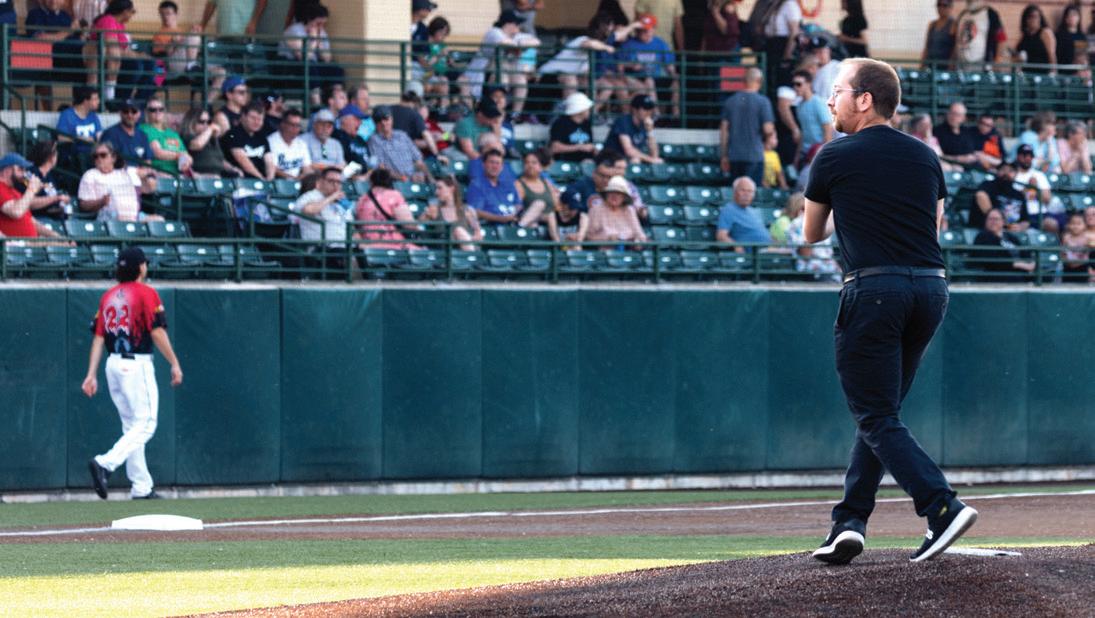
The ThunderBolts debuted in 1999 as the Cook County Cheetahs. (Crestwood’s mayor at the time, Chester Stranczek, who played in the minors in the 1950s, threw out a first pitch, as did then-governor George Ryan.) The Cheetahs joined the fledgling Frontier League, then in its seventh year as an independent association operating outside the typical Major League Baseball farm system. In 2004, the Cheetahs became the ThunderBolts, and
Windy City ThunderBolts in suburban Crestwood, certainly made me feel invited. He responded to my email request to throw out a first pitch before anyone else. He had a deep familiarity with the Reader; he used to pick up a copy every Thursday the ten years he lived in Lakeview, before I moved to Chicago. And just like that, I scheduled my debut first pitch for June 10.
Ahandful of monsters came stuttering out of the elevator on the concrete concourse behind home plate at Ozinga
artist rendering of the night’s honored guest: MeTV horror-movie host Svengoolie.
Ozinga Field holds a little more than 3,000 people, and I estimated a little more than two-thirds of the seats were filled. Of those couple thousand attendees, it seemed like half showed up specifically to see Svengoolie; most of the evening he sat at an autograph table on the concourse near home plate, and the line to meet him remained strong for at least six innings. The ThunderBolts also enlisted Svengoolie to throw out a first pitch, and he would be the last of six of us to do so. That took o
three years later they won their first Frontier League championship; they’d repeat the feat the following year. In 2020, the Frontier League became an MLB Partner League, which gave the association a new line of financial support. That summer, my buddy Daniel invited me down to a Tuesday night ThunderBolts game, and I couldn’t say no to a $2 ticket and $2 hot dogs.
My ThunderBolts first-pitch game would be my third time at the ballpark in as many years. I’d like to say I trained for the task, but I thought about practicing my throw more than
I actually did. I made something of an attempt. I purchased an unused youth baseball during the annual Ravenswood Manor Garage Sale in May, though I never got around to finding a mitt to play catch with the thing. I did practice my toss, though throwing around a tennis ball with my wife and our friend Diego in a park did not fully prepare me to step on a pitcher’s mound. Whatever training regimen I dreamed of got lost in the slipstream of summertime activities sometime between camping in Door County and watching a Barbie matinee.
I arrived at Ozinga Field with about 15 min-
as the announcer ushered me onto the field with, “Now from the Chicago Reader , here’s Leor.” I barely took any time to notice how the stadium looked from the mound, or register much beyond my burning desire to send the ball in my hand into the catcher’s mitt. I should have taken a moment to prepare myself once I arrived on the mound, but I found myself propelled through the motions thanks to a giddy mix of disbelief and anxiety. I threw my arms behind me, lifted my left thigh up towards my torso as I pulled my right arm back, and then launched the ball towards home plate.
In 1953, president Dwight D. Eisenhower threw a first pitch that hit an umpire in the back. A 1954 United Press wire story told of how the president had also planned to golf in Georgia on opening day of that year, rebu ng a presidential tradition so well-established that his absence from the Senators’ Griffith Stadium apparently upset people. Even the anticipation of the presidential first pitch qualified as news—hence the UP story, “Eisenhower Promises Control of Ceremonial First Pitch.”
In anticipation of the 1980 season, the
I might have had an easier time training to play baseball in a few months than attempting to dig through 113 years of baseball history in search of every opening toss in the same amount of time. I certainly had no trouble finding examples of public figures who’d made a cameo on the mound.

YouTube, obviously, is rife with footage of first pitches. I would be lying if I said I didn’t spend some time watching montages of the “worst” celebrity first pitches. Did I take comfort watching Carly Rae Jepsen send a ball into the ground a few feet away from the mound, or MLB great Nolan Ryan make a wild toss that veered too far right of his intended target? Sure, a little; there’s solidarity in public embarrassment.
I do take some enjoyment in trying an activity I’m not particularly good at just to see if I can do it, but I also realize the stakes are di erent for me. If I make an errant throw in front of a half-full minor-league ballpark, that memory largely stays with me. I can take ownership of my failure in this article. After 50 Cent goofed up at a 2014 Mets game, GQ published an oral history about it. The headline came from a quote from field reporter Kevin Burkhardt, who called the pitch, “The worst thing I’d ever seen.”
This project isn’t entirely novel, either. My research led me to stories written by columnists who also had an opportunity to throw out a ceremonial first pitch. In 2001, Naples Daily News columnist Brent Batten tossed one out for a single A team called the Fort Myers Miracle. Batten sought advice for his time on the mound, and Daily News general manager Bob Burdick kept it brief: “Just don’t bounce it up there.”
utes to spare before the first pitch, and as my anxiety about running late dissolved I began to worry about my ability to throw. Some of that self-imposed pressure dissipated once I walked onto the field and noticed three of the other people who were signed up to toss a ceremonial ball were children. I could do worse than a child, as I’d find out in Gary, but in that moment I felt OK about my task at hand.
One of the ThunderBolts workers brought out a bucket of lightly used Frontier League baseballs and all of us held onto our ball till we were called up to the mound. I wasted no time
It floated upwards on its forward journey for a moment, but quickly gave in to gravity and bounced a few inches short of home plate.
I left the infield just as fast as I arrived, retrieving my ball as I made way for the next first-pitch participant, another child whose throw made me feel pretty good about my effort. I’m not quite sure about Svengoolie’s fastball. After he went up to throw, the catcher, Peyton Isaacson, beckoned him closer and closer to home plate till, finally, Isaacson lobbed a rubber chicken at him.
Cincinnati Reds held a contest to come up with a creative idea to bring the opening-day baseball to Riverfront Stadium. Keen Babbage, a 25-year-old fan, suggested bringing the ball from the place it would be manufactured: Saint Louis. The 430-mile walk also functioned as a fundraiser for March of Dimes. When Babbage arrived at the park, he gave the ball to Cincinnati’s March of Dimes poster child, 5-year-old Jason Edwards, who had the honor of throwing out the first pitch.
I’d dreamed of putting together a comprehensive history of the ceremonial first pitch.
Icould not a ord to bumble my first pitch at the Rockford Rivets game. As much as I wanted to improve over my horrendous performance in Gary, my ego didn’t compel me to throw well here. When the Rivets announcer called me up to the mound, the home team and the visitors (the Kalamazoo Growlers) were queued up on the first- and third-base lines for the national anthem. The players formed an arrow directing me towards home plate. I feared a cockeyed throw would cause a career-ending injury for one of the promising athletes before me.
The Rivets have been around since 2016, and play in a stadium that previously hosted two di erent Frontier League teams, first the RiverHawks and then the Aviators. In February 2016, a company called Rockford Baseball
Properties announced the Rivets would debut later that summer as part of the Northwoods League, a collegiate association whose teams are made up of pre-draft undergraduate players. That might not qualify as professional to most discerning baseball fanatics, but these guys are on a professional track and play at a level that I, a minimally athletic 37-year-old with flat feet, simply cannot.
I drove through a torrential downpour on my way to Rivets Stadium; when I arrived I noticed Cook County had issued a tornado warning. The rain didn’t return to the ballpark, but it delayed the game. A handful of Rivets workers (including a couple players) were attempting to ameliorate the muddy patches around home base with large bags of Turface Quick Dry, an absorbent compound made with clay—folks on the infield spread the Turface onto the ground with shovels and rakes. The delay gave me the chance to chat with the person tasked with catching my pitch, Matthew Mebane. He plays for South Georgia State College during the academic year, and he’d already spent a summer with the Rivets

in 2022. In the summer of 2016, Mebane won the MLB’s Junior Home Run Derby in the lead up to the All Star game. He might have had dingers on his mind because former Oakland A’s star José Canseco rolled through Rockford a few days prior to participate in a home-run derby on the Rock River. The Rivets recruited Canseco to throw out a first pitch for that evening’s game; he tossed the ball to Mebane.
I couldn’t compete with a guy who hit more than 400 homers in the MLB, nor did I intend to try to make a bigger impression on my catcher. I just wanted to send that ball across home plate without forcing Mebane to scramble. The mix-up that sent both teams onto the infield for the National Anthem while I threw out the first pitch provided me with guardrails. I kept both feet planted on the ground and threw high, sending the ball on a trajectory that brought it down into Mebane’s mitt.

Curtis Haug’s ambition to play baseball ended in 1988. He’d been a pitcher at Florida Southern College, but after he injured himself his junior year, Haug’s throw lost some of its speed. Haug’s father encour-






aged him to pursue a career in baseball anyway, so he sent his resume to any minor-league team that caught his eye. He landed a job with the Wheelers, a single-A team based in the capital of West Virginia. “My starting salary was $800 a month,” he says. “[I] did everything; clean toilets, painted the fence signs, painted the seats, I was the PA announcer. It was a real small operation.”
In the early 1990s, his parents told him about a new minor-league team operating near his Naperville hometown: the Kane County Cougars. Haug estimates he called general manager Bill Larsen at least 30 times via a payphone before Larsen took his call. Haug began working for the Cougars in 1993; at the end of the team’s 2011 season, he became their general manager. The Cougars are the oldest operating minor-league team in the region, and they’d be the last team I’d throw out a first pitch for this summer.
As much as this story is about my experience—on the mound and as a fan of mi-

nor-league baseball—I did want some insight about what went on behind the scenes. The minors are historically seen through a subservient relationship to the MLB; these scrappy leagues exist to mold talent and prepare them for “The Show.” But even as players cycle in and out of the minors, the teams maintain a full roster and packed schedule, and play to communities that exist outside the domain of an MLB team. If I saw my time as an alt-weekly journalist as some sort of mirror to minor-league lifers, what exactly went into maintaining a team?
The Cougars’ front o ce employs 25 people. October through April, they prepare for baseball season. That means organizing around the team’s schedule, drumming up sponsorships, and finding people to buy tickets for large groups or for an entire season. “Probably the number one thing that a person that works in minor-league baseball does is sell,” Haug says. It’s a 40-hour work week till summertime. “During the season, it’s long hours,” he says.
“When we have a six-game homestand, you’re going to be here 14, 15 hours a day, six days in a row.”
In 2020, the Cougars and the rest of the Class-A Midwest League canceled their season due to the pandemic. “We lost 98 percent of our revenue,” Haug says. “We were on life support. We had to reduce the sta to four or five people.” They survived renting out the ballpark for events and hosting movie nights. The following year, the MLB reorganized its minor leagues, slimming down the number of a liated teams from 160 to 120; the Cougars were cut.
The Cougars joined the American Association of Professional Baseball for the 2021 season, the league’s first as an MLB partner. “Back when we were affiliated, the players were provided to us,” Haug says. “It was, ‘Here you go, here’s your team.’ They get o the bus and you figured it out from there. In this league, we put the rosters together. We put the coaching sta together. We pay for their salaries, their workers’ comp, their pre- and post-game meals—everything.”
Haug says the new league has given the Cougars a di erent type of player. When the team was a liated with the MLB, it featured athletes on their way to the minors. Now their roster includes more seasoned players—people who are generally a little stronger and skilled but likely already peaked. For much of the season, the Cougars roster included Pete Kozma, who won a World Series with the Saint Louis Cardinals in 2011. (The Cougars released him on August 8.)
As Haug sees it, the people who come to the park haven’t been too distraught about the change in the team’s affiliation. “Ninety-five percent of the people that come here don’t even know, probably, and don’t even care,” he says. “They’re here for the fun. They’re here for the atmosphere. They’re here to run



the bases after the game. They’re here for the great fireworks.”



And for the ceremonial first pitch. “First pitches have been a major part of what we do,” Haug says. The first pitch is an income stream—big sponsors have the opportunity to throw one out, along with people who buy a package of tickets to celebrate their birthday at the game. Sometimes the Cougars offer a ceremonial first pitch as a prize in a contest. Haug sees it as a good way to engage with the community, to let longtime fans be part of the game and celebrate public figures.
After our conversation, Haug emails me a photo from a 2004 ceremonial first pitch. In it, future Oakland A’s pitcher Dallas Braden stands on the mound next to the guest of honor, Illinois state senator Barack Obama.
Ifinally got the chance to throw out a pitch before a Chicago Dogs game on July 16. I would like to tell you my time on the mound at Impact Field was victorious. That would be half true. Three years after winning that contest, and five years after deciding the Chicago Dogs were the team (or “a team”) for me, it did feel great to be out on that mound. My wife roped in a bunch of friends for the occasion. I wore an oversized Dogs jersey the team o ered as an opening night promotion this season, and it clung to parts of my body like a wet tarp. I felt ready.
I followed a teenager who delivered a clean throw from just in front of the mound. I probably should have followed suit and tried my toss on the infield grass. Instead I went up to the mound and threw a lowball that curved downward and left. It bounced just before home plate, kicking up a little dust before it arrived in the catcher’s mitt. My friends cheered me on like that’s exactly where the ball was meant to go all along. We spent the rest of the afternoon baking in the sun, watching as the Chicago Dogs eventually lost to the Lake Country DockHounds. I would’ve liked a better outcome—for the team, and for my pitch. I’ve found this summer I’ve suffered from option paralysis, frustrated by having too many events to attend and not enough time or energy or the ability to multiply myself to witness all of it. But that day, I had no complaints about how I chose to spend my time.
My friend Mike offered to help me with my throw. He’s not only played baseball, he’s also coached kids. We met volunteering for 826 Chicago, and I saw firsthand how his gentle encouragement and easygoing temperament put students at ease and helped them gain confidence. He’s what I needed to try to improve my throw. We met on
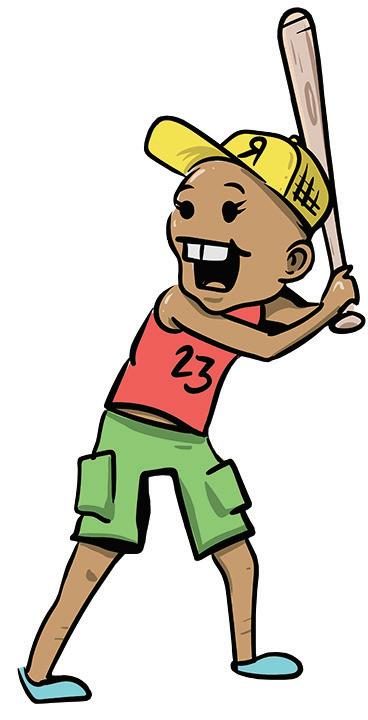
a hot mid-July evening about 24 hours before I was due to appear on the mound in Schaumburg. He took me through each step required to complete a clean throw. At one point early in my lesson, Mike apologized for potentially over-explaining anything I might already know about the basics of throwing. I told him to talk to me like a child who was learning all this for the first time; I had to get it right.
I arrived in Schaumburg the next evening before the gates at Wintrust Field opened. The Boomers are named after the greater prairie chicken, and the team fashioned the bird’s bulbous neck and elvin-like crown of feathers into a logo about as fearsome as a prairie chicken could aspire to be. The team is certainly formidable; since they debuted in 2012, they’ve captured four Frontier League championships. Canadian wildfires had drifted back into Chicago the day of the game. AirNow’s website told me the air was dangerously unhealthy, though Schaumburg’s skies were clear and sunny; I felt all 89 degrees of heat bear down on me as I walked around Wintrust Field, and I prepared for my throw by noshing on a $1 hot dog. The stadium seats more than 7,000, and even though it was a Tuesday night, people poured into the stadium by the hundreds, particularly for the inexpensive food; I had a hard time maneuvering around the main concourse as crowds clumped around concessions windows. This would be one of the largest crowds that would witness—or barely register—me throw out a first pitch.
I went over what Mike told me as I stood by the entrance to the field with the other two people scheduled to throw out a baseball. I made a “C” shape with my thumb and index and middle fingers; I placed my top two fingers above the ball’s horizontal seam, and bent my ring and little fingers to buttress the ball. I’d throw the final ceremonial pitch.


continued from p. 11
When I got to the mound, I remembered to take a deep breath and focus on the catcher. All of my previous times on the mound were brief enough for me to barely consider the perch I stood on or the crowd before me, never mind the catcher; the setting sun hit my eyes from the right, and helped me focus on my target. I heard Mike’s voice tell me to forget all the steps of making a pitch and to just throw. My baseball drifted up and slightly rightward, but I’d sent it on a trajectory that placed it right in the hands of the catcher, Hunter Hoopes. When I jogged off the field towards him to retrieve the ball, he complimented me on my throw. He signed my baseball, and scrawled his number (22) just right of his autograph. Long after I left the park, after I threw my last pitch for this story, I tracked down his information on the Boomers website. That’s how I realized Hoopes is one of the team’s pitchers.
Afew hours before I began my trip out to Geneva for the Kane County Cougars game, I spoke with 48th Ward alderperson Leni Manaa-Hoppenworth. In June, she threw a first pitch to kick o a White Sox game, and I wanted to learn about her experience— and get her advice.
I’d noted a lot of people who took part in the
game-opening tradition this year I could have talked to for the story. Actor Thomas Ian Nicholas, who played a pre-teen whose fastball lands him on the Chicago Cubs’ roster in 1993’s Rookie of the Year, appeared on the mound at Wrigley Field on July 2 to celebrate that movie’s 30th anniversary. Mayor Brandon Johnson also threw one out for the Cubs back in May. My routine work covering music has made me aware of artists who’ve been invited to lob a baseball for an MLB team outside this city; this year, I noticed Yo La Tengo guitarist-vocalist Ira Kaplan threw one out for the Mets in June, and all four members of Turnstile shared the honor of tossing out the opening ball at an Orioles game in August.
I have a shared history with Manaa-Hoppenworth, who worked as a Reader sales representative till she decided to run for public o ce. She’d been one of ten candidates vying for the 48th Ward’s aldermanic seat; she won the runo in April, becoming the first Filipino-American elected to city council. As the White Sox began planning a Filipino heritage day celebration for June 24, the team reached out to Manaa-Hoppenworth to participate in the game-opening ceremony.
“It was an experience that was probably the most stressful moment in my aldermanic career—up to that point,” she says. Manaa-Hop-
penworth grew up watching the Sox with her family in the south suburbs, so being asked to represent the city’s Filipino community for a home game brought pride and pressure. And then there’s the size of the stadium; Guaranteed Rate Field can fit a little more than 40,000 fans in the stands, dwarfing even the largest stadium I’d visit for this project (Kane County Cougars’ Northwestern Medicine Field, which can seat almost 11,000 people). “I wanted to be there, I wanted to represent, but I also didn’t want to fail,” Manaa-Hoppenworth says. “I had to think to myself, ‘What does it mean to be successful?’”
She came up with a goal: don’t bounce the ball. She sought out pointers from friends and family, and practiced her throw in the weeks leading up to the big game. “The biggest thing that I thought that was most useful is you can’t just let your arm do all the work,” she says. “You have to involve your whole body.” Out on the infield at Guaranteed Rate Field, sporting a Sox jersey that brandished her last name above the number 48, she dashed out to the pitcher’s mound, touched it with a foot, then ran closer to the catcher to toss the ball. “And it landed right in the mitt,” she says.
Manaa-Hoppenworth suggested I should perform a pirouette before my pitch at the Cougars game, but I’m afraid to say I was a
little too discombobulated to pull it o . I was the third of four people to throw out a ceremonial ball that evening. Just before my turn, the Cougars employee who guided us onto the infield told me I couldn’t throw from the mound—the grounds crew liked to keep it untouched for the actual game. I hadn’t practiced since my throw in Schaumburg, and I gripped the baseball a little too tight. My throw went high, to the right, and into the backstop. At least it didn’t bounce.
As I walked up the stairway leading me from third base to the main concourse, an elderly Cougars fan turned to me to say, “Good job.”
“I tried,” I responded. That got a laugh.
When a baseball player ascends to the majors, the minor-league teams that once housed and incubated and sculpted said athlete usually pay homage to the rising star. The Windy City Thunderbolts, for example, were once home to David Axelrod, who played a couple seasons for the White Sox in the early 2010s. Three Kane County Cougars alumni—Willson Contreras, Albert Almora, and Kyle Schwarber—were on the Cubs’ 2016 World Series roster.
I understand the minor leagues o er ticket buyers the chance to see a potential MLB star in the making on his ascent, but prospecting

doesn’t draw me to the ballpark. I’m there to razz on the Chicago Dogs ketchup mascot, or because the Kane County Cougars and Rockford Rivets let fans bring their dogs to their respective games as part of a promotion called Bark in the Park, or because the Schaumburg Boomers let people run into the outfield to participate in a marshmallow fight after a game, or because, in general, the tickets are a ordable and it’s a nice way to spend a few hours outdoors with friends. I go to see athletic feats and sloppy errors up close, because it doesn’t matter how big of a stadium I’m sitting in or what kind of baseball I’m watching if the play on the field surprises me.
This summer, I spent a lot of time considering the parallels between minor-league baseball and alternative newsweeklies. The Reader has a history of helping talented writers, editors, photographers, and art designers with their respective crafts—plenty of whom have been whisked away by bigger news outlets with larger budgets. But this paper doesn’t exist to mold talent for larger outlets. The Reader has a distinctive voice, which is constantly shaped by staffers and contributors who have the kind of deep expertise required to publish stories you can’t find in any other local news outlet. We have a legion of fans too, and while the size of our readership is smaller than that of the dailies, I think we’re still able to give the people who read us a reason to pick up every new issue. I also like to think our work can still surprise our readers too.




I thought back to the night I went to Rockford to throw a first pitch for the Rivets. It’s difficult to draw people to the ballpark on a weeknight, and even harder a couple hours after the skies have drenched the ballpark. The Rivets’ website notes 473 people attended that



“I gripped the baseball a little too tight. My throw went high, to the right, and into the backstop. At least it didn’t bounce.”
game, though when I surveyed the stadium after I left the infield it looked like no more than 100 fans were around. It reminded me of all the times I spent pouring energy and time into stories that went virtually unnoticed—it can make working on the next story just a little more challenging. But I felt encouraged by the sight (and sound) of the Rivets players cheering whenever one of their teammates successfully earned a hit; these players were there for each other regardless of who showed up to watch them. The Rivets ended up losing to the Growlers by three runs.
The Gary RailCats played a miserable game following my disastrous ceremonial toss on June 10. But in the bottom of the 8th inning, first baseman Emmanuel Tapia hit a pitch with such authority that the sound caused me to leap up before I could see the ball sail over the outfield wall. His homerun gave the RailCats their first, and only, two runs. They’d lose to the Cleburne Railroaders by seven. The final score couldn’t scrub the euphoria I felt seeing Tapia smack that ball out of the park any more than his performance could undo the numbing sting of defeat. Baseball at any professional level sure knows how to twist up my emotions.
Sixty feet and six inches separate the back of home base and the plate on top of the pitcher’s mound. For six games, I planted my feet on that plate—or as close to it as the Kane County Cougars grounds crew allowed me. Would I have liked to have pitched better? Sure. But even my poorest performance couldn’t erase the gut-churning thrill of hearing the announcer call me on to the mound as if I belonged on that perch. And, for a handful of moments this summer, I did. v
A Chicago-style hot dog at the Chicago Dogs home opener on May 12 LEOR GALIL

Idon’t eat meat much these days, but I make an exception for hot dogs at baseball games. This has become sacrosanct. I upheld the tradition while visiting the northern tip of Wisconsin’s Door County, Washington Island. The town’s population hovers below 1,000, but that’s enough people to support the Islanders, who play in the amateur Door County League. The game I caught was slow and sloppy, to the Islanders’ benefit—they were up by ten points in the third inning. The hot dog hit the spot. Here are photos of some of the hot dogs I’ve relished while attending baseball games this summer. v
m lgalil@chicagoreader.com
On May 28, I ate a hot dog at a game on Washington Island, Wisconsin, home to the Door County baseball league team the Washington Island Islanders.




Here’s a hot dog with mustard and relish, which I gobbled before my ceremonial fi rst pitch at the Schaumburg Boomers game on July 25. I should have eaten more hot dogs before my pitches, since this happened before my best outing on the mound.


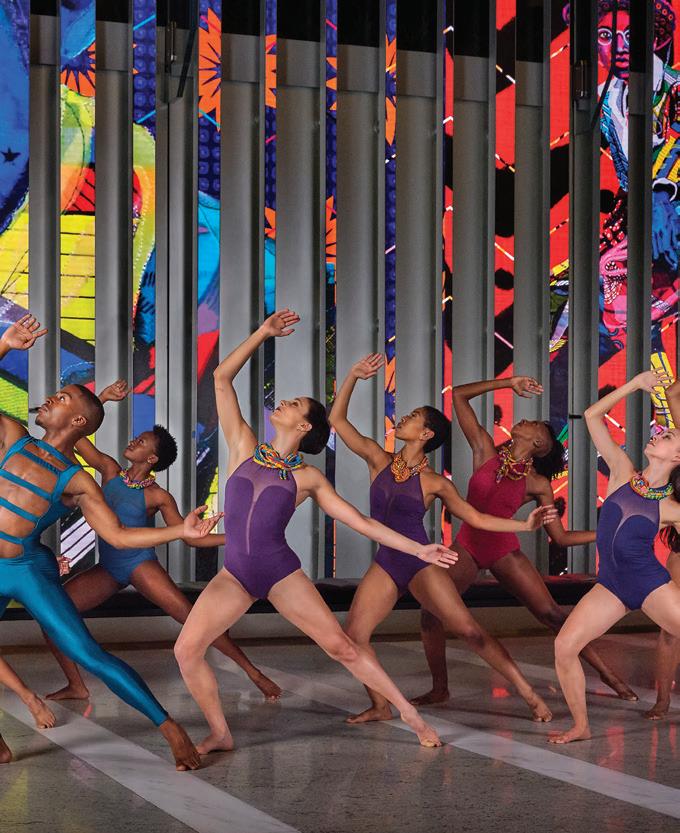


Even a er closing the legendary Mado, his cooking never stopped evolving.
By MIKE SULARob Levitt could’ve been the chef at the Publican. In the spring of 2019, after spending nearly a decade as the reigning craft butcher of Chicago, he was ready to exit the Butcher & Larder, the pioneering, initially independent meat shop he’d founded. Creative di erences with new management at its home base Local Foods were showing him the door, and Paul Kahan of One Off Hospitality had opened an attractive new one at his beer, oyster, and pork emporium.
It seemed like a perfect fit, and it would have been glorious news to the old and endur-
ing fans that had been dreaming of his cooking ever since he and his wife Allie exited their beloved Wicker Park restaurant Mado under cover of night to open B&L. At the time, there was a convenient shorthand acronym circulating among Levitt stans to express disappointment in a restaurant meal—S.H.E.A.M.: Should Have Eaten at Mado.
It didn’t happen. Alternatively, Kahan offered him a better fit: the top spot at One O ’s adjacent Fulton Market butchery and cafe Publican Quality Meats.
In truth, Levitt never completely left the kitchen behind. Between breaking down pigs
and stu ng sausage, B&L occasionally hosted family-style dinners showcasing the uncommon and unusual meats he was known for; and PQM hosts regional wine and product-driven dinners after hours here and there. But it feels like forever since folks could regularly eat through the simple, seasonal, broadly midwest-Mediterranean menus Levitt first made his name on.
That all changes early next month when One O introduces PM at PQM, a casual after-hours cafe featuring a debut menu of plates that is at once hauntingly Mado-esque and evolved, coming from a chef who’s done a lot of eating,
Find more one-of-a-kind Chicago food and drink content at chicagoreader.com/food.
cooking, and living since 2010.
A few things you won’t eat from it are cheese and charcuterie boards. “We do that during the day, and we do it for catering,” he says. “And that’s fine. I stand behind everything we put on those boards. But I think going to a restaurant and getting a meat and cheese board is just a little bit boring—and this is coming from a guy who makes meat stu .”
In some ways it’ll be an extension of PQM’s occasional, rare charcuterie dinner series when Levitt centers some of the most exceptional things he and sous chef Kyle Hu have produced. “I have this small handful of farms that raise really superlative pigs. They’re heritage breeds and they’re 100 percent pasture-raised, and there’s a real story behind these people and their animals. The idea behind these dinners was a showcase for the extra special stu , like the mortadella that we put so much time into, or something like a culatello. I have one hanging in the curing room that’s going to be a year old in a couple of days. It’s just pork and salt, and you taste it and your head explodes.”
You’ll have to wait a few more months for that particular cranial eruption, but that creamy, lush mortadella, which he and Huff perfected over six months (with advisory emails from Levitt’s hero, former Chez Panisse chef Paul Bertolli), will be draped on the plate with a handful of gnocco fritto—crispy lard-enriched pillows of fried dough, with shaved parmesan and a drizzle of balsamic vinegar.
There’s going to be a ri on the Gilda, the classic Basque pintxo of toothpick-speared anchovy, olive, and piparras pepper, subbing out the tiny fish for ribbons of pickled pork tongue; while La Pryor Farms’ dry-aged bottom round carpaccio will be plated with pickled, tru ed dwarf peaches, and hard cow’s milk Piave Vecchio cheese. He’s making an agrodolce out of pickled pine nuts to be served with fresh ricotta, and a fermented apricot mostarda with mustard seeds to go with the Prairie Breeze aged cheddar he’s obsessed with.
This time Levitt has the deep resources of the One O empire behind him. He’ll be serving Publican Quality Bread’s honey oat porridge sourdough with whipped (dairy) butter, and the “pork butter” he makes from rendered lard, seasoned with rosemary, garlic, chili, and
Dinner service nightly starting in early September





Publican Quality Meats, 825 W. Fulton Market 312-445-8977, publicanqualitymeats.com
citrus zest; and crispy, pressed focaccia with gooey robiola, topped with marinated summer squash, and cherry tomatoes. PQM’s signature ham and butter baguette is making the move to the night menu as well.
Levitt and Huff intended each of these plates to be legitimately shareable (and not only in name) and eaten with the food-friendly wines PQM sells by day—priced for retail, not standard restaurant markups. The soundtrack will be the hard pop and mid-60s, up-tempo jazz Levitt studied as a sax player before he discovered cooking.
Early in his career, Levitt staged at One O ’s late flagship Blackbird, and Avec, hoping to land a permanent spot. Even afterward, he continued to buttonhole Avec’s chef and Chicago cured meat pioneer Koren Grieveson for guidance on his first meat preservation projects. “I made it a point to try and make friends with her. And she was either gonna like me, or I was gonna annoy the hell out of her. I would stop by after I got out of work and bring her stu that I made and say, ‘Can you please try this and tell me if it’s terrible, or on the right






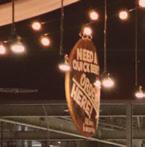
track?’ And she was totally into it. To me, it’s a full circle moment, because she was a major part of me learning how to do this stu .”



Levitt says people who’ve followed him from each retail spot ever since Mado closed continue to reminisce about special nights at the restaurant or particular dishes they remember—particularly Allie’s desserts. These days she’s working front of house at Avec, so sadly, her famous shortbread won’t be part of this comeback.
Levitt might take some requests, though.


“One of the things that is so cool about this project is that sometimes people bring up, ‘Man, I remember this one dish I had at Avec,’ and oftentimes it’s something I don’t even remember making. We’d do these dishes and often it was something fun, but when it was gone, it was gone. But this evening thing gives me an opportunity if someone comes and says, ‘Man, I remember that one dish was so good,’ maybe it’ll find its way on the menu at some point.”
m msula@chicagoreader.com






















CRA
OVERDOSE AWARENESS MEMORIAL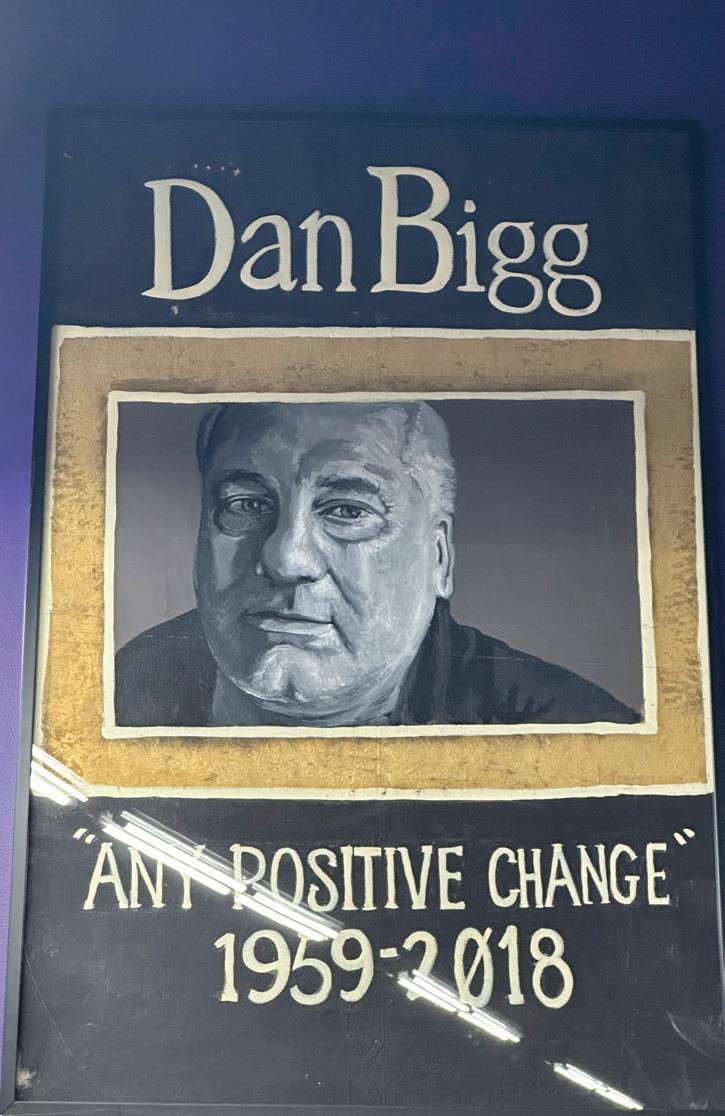
Five years a er his death, the groundbreaking work of the harm reduction pioneer lives on at the Chicago Recovery Alliance.
By KATIE PROUTIn August, the m osquitoes on Taylor Street between Sacramento and Kedzie swarm as thick and lazy as a muddy river. They rise languidly from the green grass gone wild that runs up against the freight train tracks that go for blocks on the south side of the street, and head toward the smell of sweat and barbeque. They are slow, but like the devil, they stay busy. Each one I slap leaves a smear of blood. Across the street, the garage door of the Chicago Recovery Alliance is open. People and dogs ease in and out. A man from Indiana pulls up with a truck full of watermelon for sale. Another man, also from Indiana, is here to talk about syringe exchanges. Outside, music blasts from parked cars while folks from the neighborhood sit on benches left here years ago and folding chairs just pulled from trunks. Some are younger, but most are over 50. Waving fans and flyswatters, they’re here to talk shit, play spades, and remember.
Last year, 30 or so people from the CRA and the block around it came together, despite the mosquitoes, to plant a tree. It was August 31: International Overdose Awareness Day, and four years since harm reduction pioneer and CRA cofounder Dan Bigg died at age 59. Every August, the CRA—a harm reduction organization that o ers drug testing, sterile syringes, condoms, and other free useful tools for staying alive—hosts a barbeque for volunteers and the neighborhood. The tree, a Merlot redbud, was planted in Dan’s name.
I started volunteering at the CRA in the fall of 2019. Then, it’d been a year since he died. Everywhere in the warehouse, I saw Dan’s
face: in photos and on T-shirts, in the oil and ink of art framed on the walls. I soon learned that Dan was a lifelong activist and Chicagoan who, in the 1990s, supplied syringes to people in need when doing so was illegal. He is often described as the fi rst person in the country to get naloxone, the lifesaving opioid overdose reversal medication also known by the brand name Narcan, out of the hospitals and ambulances and onto the streets, where the majority of overdoses occur.
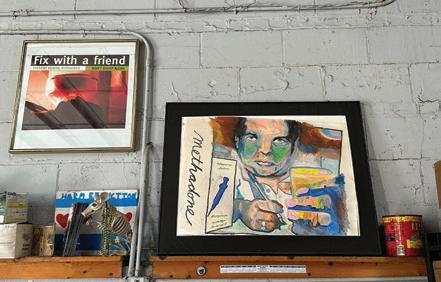
“But his legacy is far more than simply handing out naloxone,” wrote Maia Szalavitz for Vice in 2018, “though he did tons of that, often carrying du el bags full of the stu to conferences to urge those who wanted to help to start programs in their own communities. Dozens took him up on it: by 2014, there were more than 644 known naloxone distribution sites across the US.”
Harm reduction, a philosophy founded by sex workers and people who use drugs, centers bodily autonomy and individual choice by taking practical steps to make drug use and sex work safer. Because harm reduction has been done largely by and for the marginalized, its history is sometimes overlooked at best, and rewritten at worst, by more mainstream public health movements and organizations. Taking the time to reflect on that history is like a gut check, helping root us in legacy and know where to go next.
This August 21 marked the five-year anniversary of Dan’s death. As the CRA gets ready for their 2023 barbecue, I dropped by to learn more about Dan and his legacy from folks who knew him best. Those conversations, lightly edited, are below.
Dan was one of the 13 founders of the Chicago Recovery Alliance. He pretty much brought harm reduction, as opposed to risk reduction [similar to harm reduction in some ways, but with abstinence from sex work and drug use as its goal], to Chicago, and probably to the midwest. He was always happy to explain it to folks. He wasn’t ever bothered by people asking him questions.
I met Dan here at the Chicago Recovery Alliance. We both had dogs—that’s what initially connected us. I’ve been working here since 2000 and started volunteering here in 1998. In 2000, we started a youth program. That was really cool. We worked with kids aged 16 to 25: they would just go to their own groups and do needle exchange. And then we would get together and talk about stu that they wanted to talk about.
What drew you to Dan?
You know, he was really funny. Yeah, he was hilarious. We were both Capricorns, so sometimes we butted heads a lot. [Laughs] But mostly he would defuse any situation with a joke.
He was good at coming up with ideas, and organizing people to work on ideas. I was telling [a volunteer] that when they started the CRA, they had two sizes of syringes. Now we have all these things! He was really good at just nurturing people to let their creativity come out. He might not have thought of, “Let’s pass out pipes,” but he gave other people the freedom to.
Where do you see his legacy today in Chicago?
All the harm reduction places that exist now, like the Opioid Task Force on the south side [and] Opioid Task Force on the west. He popularized it, just by sheer force of will and networking with people. He did it kind of seamlessly too. He didn’t need to be patted on the back for all that stu .
One of the other things he brought about was our board of directors. He was adamant about [people who used CRA services] being in charge, so in our case, the whole board was people who were also participants. I don’t know what our board looks like now, and I don’t know if that has become popular—I think sometimes when people do that now, they have an “advisory board,” not so much
the board of directors. I think us maintaining that sets a pretty good example for other people who want to do this kind of work.
What do you think he’d think about Chicago Public Libraries carrying Narcan now?
I think he’d be thrilled. Cook County [the John H. Stroger Jr. Hospital] was a hospital that he was trying to get the Narcan into: he wanted them to give it to people who came into the emergency room. He had to do a lot of cajoling for that one.
One of the things we were able to do for a couple years—again, by sheer force of will— was start a mobile methadone program [to distribute medication used to treat opioid dependency]. We had a van like this one [ gestures out toward the tree, where a silver van is parked ] built out to be like the mini methadone program. The—we call it the methadone mafia—[those other, more formal methadone clinics] didn’t like that. We were so inexpensive, and a lot of the people that they were seeing started coming to us. We were also low barrier—we didn’t make up arbitrary rules like, “You have to be here six months before you can go on vacation.” The state of Illinois shut us down. That was a big blow. [Dan] always hoped to start that up again.

Yeah, there still are no mobile methadone programs in Illinois, though the state greenlit a pilot mobile suboxone program to treat dependency in 2022. What are some of your own hopes for overdose prevention and education in the next five years?
Well, making some big steps toward having a safer injection space is something I would love to see. And I think Dan would love to see that, too.
How are you doing, five years on?
It’s sad without him. My daughter has been keeping me busy—we can either commiserate together, or sometimes she’s just doing her own thing. That helps me. But now she’s going to college. So I’ve been thinking, “Am I gonna start feeling everything?”
I didn’t use his last name until he died. It’s kind of a way to keep him close. When he died, a harm reduction therapist started working with me two times a week. And that’s been a really big help. Now it’s down to once a week. I’m just getting used to that.
[Pier points at her pants] This is supposed to be for the mosquitoes. Hell, they still fi nd a way to bite me!
Seriously. How did you come to know Dan?
I was introduced to Dan by one of the guys I used to work with on BEHIV [Better Existence with HIV] in 1997. Me and Dan hit it right o . I started going out there on the van. He was actually like a mentor to me, and at one point, he o ered me a job. I was like, “Damn, I’ma have to cut you.” “What you’re gonna cut me for?” “About my money!” I said. [Laughs] And so I said, “Well, we’ll just stay and keep it like it is.” I rode the van and he educated me.
We stayed friends up until he passed away. Actually, his daughter is one of my godchildren. She’s very dear to me. Beautiful little girl, but she’s in college now, which is great. Dan absolutely cared about people; wasn’t nothin’ fake about that. He wanted people to use safely. Early on, he was doing a lot of underground work. I’ve heard the story that 68th and Halsted was his fi rst site. It used to be two big courtyard buildings on the corner. A lot of the individuals that lived in that building, they were Vietnam vets, and they was all sharing equipment. And Dan was one of the folks that was distributing them clean needles out of his station.
You’ve mentioned before that he was your mentor. How do you mean?
Oh, I learned all about hepatitis and intravenous drug users. The syringes is di erent gauges: some are long, some are short. We also provide syringes for diabetics, which could also be used as well for injecting drugs. Just working on the van, going to different community areas, I learned about that community area. We joked, we laughed, we always have fun.
How do you see his legacy, five years later?
The CRA, we’re still here. Everybody is carrying Narcan, and Dan kinda opened this gate up. They protested, they marched on Springfield. He fought, fought, fought. Hollered, screamed, did whatever he had to do to get that. And now they’re starting to listen, because they see the number of overdoses. Every year it’s a new record. I saved four people’s lives last week out here.
Tell me about that.
Oh, child, they was overdosing. Each time, somebody ran in here and said, “Grab one of them things!” That’s just how they said it, and I knew what they was talkin’ about. I got somebody coming in, they was born in 1940. Vietnam vets, they have PTSD. One, he comes every Saturday still, to 68th and Halsted. I work that site now. It’s one of my favorite sites.
[Pier starts walking toward a client, then yells over her shoulder.] He was like a big teddy bear. Put that in there!
continued from p. 19
John Werning, 34, CRA executive directorDo you want any bug spray? [John gestures to a table where a citronella candle is burning next to four bottles of bug spray.] We have the natural stu too.
I’m good for now, but thank you. What’s the last year been like since you planted the tree?
Well, I wish we could get these damn vending machines placed, but nobody wants them!
Talk to me about that.
We have three vending machines [of Narcan] that are stuck inside [the CRA warehouse]. And we get, like, 90 percent of the way through finding a place to place them. And then the other entity will always back out. I’ve talked to [the Chicago Department of Public Health] about this too, and apparently they have the same problem. We can’t get them a partner agency. It’s super sad.
When did you meet Dan?
I fi rst met Dan when I was 24. He would be on the phone with me for four hours at night. I’d call him up and be like, “Hey, I have a question about this.” And then we’d get into a tangent. I remember having to be like, “Dan, it’s 9 PM. I have to go! Love you.” It’s so incredible to me that he gave me the time. He was very generous with his knowledge and information. There was always something comforting about that.
Dan was brilliant, very talkative. And also, and I say this with love, a little territorial. In 2014, there wasn’t a lot of funding, broadly speaking. The world of harm reduction funding has changed drastically in the last ten years. So we’d be talking about grant funding, and I’d say, “Well, TPAN [the Test Positive Aware Network, an organization that serves people living with or vulnerable to HIV] is looking at going for some independent grant funding.” And he’d be like, “Well, John, you shouldn’t be going after my money.” [Laughs]
When he died, it was devastating. It really felt like a little bit of sunshine had been blown out. He had an outsized role—still does—in Chicago harm reduction and national harm reduction. It happens very often where I meet with funders, and they say, “I knew Dan for 20 years and we did X,Y, Z together, and he was just such a huge influence in my perspective.” Right now, we’re trying to buy more pipes. We just met with Smoke Works, and they were like, “Dan was pivotal in getting us o the ground, and we wouldn’t be here if it wasn’t for him.”
[Karen Bigg, who was sitting with John and I, answered:] People still can’t wrap their heads around the idea that abstinence is not the end. We work with a lot of organizations who are all about giving people syringes, naloxone, and all that, but with the goal being that [the person using drugs is] going to stop someday. Dan believed that people should do what they want to do. You have the right to do it safely.
What did you learn from Dan?
[Back to John] I learned to be excited about harm reduction. I don’t know how to put it: It’s not that I wasn’t excited about it before, but he made me excited to learn about it, to understand the context, and, in the same way, to also be very angry at the war on drugs. Just how intersectional it all is. I probably have a stack of Post-it notes of quotes of his in my house. There’s a lot of great Danisms.
What’s one?
Maybe this is too morbid or sentimental, but he used to say this thing I posted in a number of the agencies I worked for: “Loss is often a better motivator than success.” Which is why we see so many advocates come to harm reduction after they’ve lost someone that they love.
Yeah. Grief often can be gasoline.
I think about that quite a lot.
Ayear later, a bench has shown up beneath the tree, which continues to grow. Even with the mosquitoes, it’s a beautiful spot, sheltered by larger trees and dotted with leggy Queen Anne’s lace and purple clover. On my most recent visit, the CRA’s silver outreach van was parked next to it, “VEHICLE FOR POSITIVE CHANGE” spelled out in black letters above its back doors. “Any positive change” was at the core of Dan Bigg’s embrace of harm reduction, something he repeated so often that it’s on CRA T-shirts and their website URL. In the doors’ dust, someone had taken their finger and drawn a round little heart. v
m kprout@chicagoreader.com


As the leader of the Chicago Black Dance Legacy Project, Princess Mhoon is on a mission to raise awareness around the necessity of Black dance in the city and beyond.

CBDLP was launched by the Logan Center for the Arts at the University of Chicago and the Joyce Foundation in 2019, in response to a report titled “Mapping the Dance Landscape in Chicagoland,” which revealed that in 2015, 56 percent of grant dollars awarded to local dance organizations went to three predominantly white companies. The multiyear initiative is dedicated to reducing those clear inequities by empowering a select cohort of Black-led dance organizations throughout the city.
With Mhoon—a nationally renowned choreographer, director, and scholar—at its helm, CBDLP has worked to celebrate the historic impact of Chicago Black dance, while strengthening its reach for future generations.

In recent years, a core focus of Mhoon’s work has been exploring the intersection of art and technology, and how it can upli Black dance. This theme can be seen through her dance film Color in Motion, a public digital art installation presented by 150 Media Stream, and The Big Bang: Movement Theory + the Black Dancing Body, a 2.5-acre digital projection that Mhoon directed for the Art on The Mart program. The latter features original choreography from the dance companies in the CBDLP cohort, and is on display nightly across the exterior walls of the Merchandise Part at 9 PM and 9:30 PM sharp through September 13.
This summer, Mhoon and the companies within the Chicago Black Dance Legacy Project cohort have been exploring the possibilities of art and technology together as they gear up for a group performance at the Ravinia Festival on September 7 titled Metamorphosis. We spoke with Mhoon to learn more about that performance and more.
Through the creation and presentation of your dance film Color in Motion, what did you learn about the benefits of combining dance with technology?
There are so many pros and cons to transferring live performance into media. The wonderful thing is that those moments can live forever. I think that one of the reasons that dance can be forgotten over time and therefore less important in the grand scheme
of history by some, is because it’s fleeting. Dance is a visual and visceral experience and then it’s gone. So to see those moments live on forever through media art was such a joy.
What inspired you to direct The Big Bang: Movement Theory + the Black Dancing Body, as seen at Art on The Mart?
From the very beginning, I knew what a great opportunity this was for me as a director to be able to tell any story that I wanted on the largest digital art platform in the world. I thought that this would be the perfect opportunity to continue to shi consciousness around how people perceive and experience Black dance. There’s no denying that we’ve been here since the beginning of time, and a lot of movement aesthetics began right in Africa. So I really wanted to tell that story, but I wanted to tell it in a way that took people on a journey that was educational and entertaining.
For the Art on The Mart projection, what was it like to direct the work of multiple dance companies, especially as you explored the theme of Black dance over time?
The Art on the Mart projection was a great vehicle to share my own story and the story of those that have influenced me over the years, including the story of the ten companies of the Chicago Black Dance Legacy Project and the decades of dance pioneers in Chicago and beyond. I set out to create something that would be meaningful to the cannon Black dance history, but also American cultural and social history on the largest digital art platform in the world.
The concert is called Metamorphosis, and we’ll be looking at transformation in all its forms. We’re really playing with this idea of Afrofuturism, which will be integrated into the performance. Ravinia will be a new venue for us, so with this performance we aim to break down barriers for the audience to understand our aesthetic and invite them into our world. I hope that they take away that the Black dance experience is accessible to everyone.
How do you see the intersection of dance and technology evolving in the coming years?
Dance and technology is not new, but it is definitely ever evolving and reaching new heights. Everyone has danced or will dance in their lifetime. Whether they do it as a child in joyful response to music, at a party with friends, or as a part of a cultural ritual. We also all love to see movement. Movement is life and once you stop moving, that’s it. Life is over. So I think we will continue to see dance on these larger platforms now that we can make it more accessible.
To purchase a ticket to the Chicago Black Dance Legacy Project: Metamorphosis, visit ravinia.org. For more about Art on the Mart, visit artonthemart.com.”
The Chicago Black Dance Legacy Project is a program of the Logan Center for the Arts at the University of Chicago. Their current cohort of local dance companies includes Chicago Multi-Cultural Dance Center & Hiplet Ballerinas, Deeply Rooted Dance Theater, the Era Footwork Collective, Forward Momentum Chicago, Joel Hall Dancers & Center, M.A.D.D. Rhythms, Move Me Soul, Muntu Dance Theatre of Chicago, NAJWA Dance Corps, and Praize Productions Inc. For more about CBDLP, visit chicagoblackdancelegacy.org, and chicagoreader.com/special/ logan-center-for-the-arts-at-the-university-of-chicago.
and technology with their upcoming performance, MetamorphosisPrincess Mhoon. Photo by Matt Karas
“Today the dream is alive,” Mayor Brandon Johnson told a crowded room of supporters at his election night party in April, invoking the words of civil rights leader Martin Luther King Jr. in his victory speech. “Tonight is the beginning of a Chicago that truly invests in all of its people.”
Johnson’s resounding victory was due in no small part to an expansive, multiracial coalition among Chicago’s political left. Those in its ranks included powerful labor unions, a diverse and dedicated cadre of grassroots community groups, and progressive political organizations. The race was dominated by sensationalized coverage of crime and violence, and pitted Johnson against a right-wing opponent backed by the Fraternal Order of Police Chicago Lodge Number Seven—the city’s largest police union. Johnson’s triumph was, in many ways, a resounding rejection of the status quo.
Instead, Johnson embraced proposals that for years had been cast to the margins. He supported efforts like Treatment Not Trauma, which calls for the creation of a citywide nonpolice crisis response, and vowed to reopen community mental health clinics shuttered by former mayor Rahm Emanuel.
Now 100 days into his first term, Johnson says he wants to govern with consensus. He’s met with business leaders and community organizers alike. And he’s thrown his newfound power behind key progressive priorities that sat sidelined for years. But he’s also tapped as top advisers people with deep ties to the political machine, and has tempered his tone on an unequivocal campaign promise. Will he stay committed to the movement that put him in o ce? Can he shirk an entrenched system of power that has long resisted such change? Only time will tell.
Chamber of Commerce, Illinois Manufacturers’ Association, and Illinois Retail Merchants Association. The mayor and his team have repeatedly sought to assuage leery business owners that he is, in fact, “not anti-business.”
On the campaign trail, Johnson backed up his progressive agenda with a commitment to invest $1 billion into Chicago’s communities. To the chagrin of the business elite, much of that money would come from taxes on the city’s wealthiest residents and corporations, including a monthly, $4-a-head employee fee for large companies with offices in Chicago; tax hikes on hotels, jet fuel, and high-end real estate transactions; and a new fee on securities contracts like stocks and bonds.
Johnson’s support proved key for at least a couple of those proposals, which languished for years before the City Council. The Bring Chicago Home ordinance, pushed by a coalition of community and labor groups, seeks to create a dedicated funding stream for permanent, a ordable housing by creating a “mansion tax” on the sale of properties worth more than $1 million. Johnson pledged to support the ordinance during his mayoral run—it was the first item on his affordable housing plank—and doubled down in advance of a subject matter hearing in July before a City Council committee. (July’s hearing came eight months after then-Mayor Lori Lightfoot and her allies blocked a hearing on the proposal.)
“I want people to understand: This issue was decided in April, when the voters elected Mayor Brandon Johnson,” Alderperson Carlos Ramirez-Rosa, Johnson’s floor leader, said during the July hearing. “So this is no longer a question of ‘if’ this will happen. It’s ‘how’ it will happen.”
The mayor recently signed o on a proposal to create a three-tiered tax bracket, the Chicago Sun-Times reported. Under the plan, tax on properties sold for under $1 million—more than 94% of all sales—would be cut by 20 per-
cent. Properties sold for $1 million or more, and those sold for more than $1.5 million, would shoulder the increase. The Sun-Times reported Johnson’s allies hope to introduce the ordinance in September and receive Council approval by October. It’d then require approval from a majority of Chicago voters in March’s presidential primary election.
Johnson’s allies on the City Council vowed to pass the measure this fall. If advanced, a majority of Chicago voters would have to approve the proposal, potentially as early as March’s presidential primary election.
In an interview with the Reader , Johnson said, “Everything is lining up for us to get [Bring Chicago Home] done” this year. “You had an entire movement that did not give up on finding a real solution to deal with the housing crisis that we have in Chicago. That part gives me tremendous joy.”
Treatment Not Trauma, which seeks to create nonpolice crisis response and reopen shuttered mental health clinics, likewise received a much needed boost in June when a City Council committee held a subject matter hearing on the proposal. The ordinance’s sponsor, Alderperson Rossana Rodriguez-Sanchez, said she hopes the hearing laid the groundwork for parts of the package to be included in the 2024 municipal budget.
“We’re well positioned to continue to grow and move towards a more progressive city,” Johnson said.
Even before his election, the business community wasted no time making its opposition to new taxes known. In the weeks following his election, the Chicago Tribune reported, Johnson held meetings with a handful of leaders from groups including the Chicagoland
Perhaps as part of that strategy, Johnson selected as key advisers a pair of clout-heavy bureaucrats. Chief among them: his chief of sta , Rich Guidice. Guidice has worked under four mayors during his three-decade career in city government. He got his start in construction for the Chicago Board of Education, before ascending to a role in former mayor Richard M. Daley’s o ce. He left that post four years later for a leadership position at the Office of Emergency Management and Communications (OEMC), where he’d spend the next two decades. At first, Guidice oversaw security for major events like the 2012 NATO Summit. Then, in 2019, Emanuel elevated Guidice to the top post at OEMC, a role he maintained throughout Lightfoot’s tenure.
During Guidice’s nearly 20 years with the department, OEMC grew into a massive panopticon of surveillance, amassing a network of more than 50,000 publicly funded cameras on street corners, in buses and trains, on public housing properties, and in schools. That’s in addition to an untold number of private security cameras shared with the city through OEMC’s Private Sector Camera Initiative. And as executive director, Guidice and Lightfoot moved to shield live police radio transmissions from the public.
John Roberson, whom Johnson named chief operating officer, is another familiar face around City Hall. Roberson, also an alum of Mayor Richard M. Daley’s administration, was once a rising star in Chicago politics, having served as commissioner of three city departments in addition to a stint with the Chicago Housing Authority. He left in 2005 alongside more than a dozen other Daley cabinet members who were sacked or resigned in the fallout of a series of public corruption scandals.
Roberson also worked a smattering of private-sector jobs—notably, almost three years with the Chicagoland Chamber of Commerce—before joining Cook County Board president Toni Preckwinckle’s o ce.
Johnson’s community credentials, on the other hand, are buttressed by another pair of top advisers. Soon after taking office, Johnson named Garien Gatewood the city’s

“No longer a question of ‘if’ this will happen”
fi rst-ever deputy mayor for community safety. Under previous mayors, the position was called deputy mayor for public safety. In this role, Gatewood will collaborate with a host of community partners to address harm. Until now, this was largely left to law enforcement, with little space for community input. Gatewood comes to the administration from a long career in criminal legal reform, most recently as director of the Illinois Justice Project.
Cristina Pacione-Zayas brings a résumé grounded in community organizing to the fi fth floor. Before Johnson named her deputy chief of sta , Pacione-Zayas was a progressive stalwart in the state senate, carrying legislation on everything from rent control, to education for incarcerated people, to protections for freelance workers. She began her career shaping education policy with the Latino Policy Forum, Enlace Chicago, and the Erikson Institute.
Johnson praised his team for bringing a “wealth of experience . . . that reflects the fullness of the city of Chicago.” He added, “That’s the essence of who I am and what my
administration reflects: that we are literally bringing people together.”

Johnson centered community safety as a core focus of his candidacy, vowing to address harm holistically by investing in things like youth employment and a ordable housing. It was a welcome change for community members who for years have demanded the city focus on the root causes of crime, instead of heavy-handed policing, surveillance, and incarceration.
While he rebuked calls to shift funds away from the Chicago Police Department (CPD)— he promised not to cut “one penny” from the department—he was unequivocal about another popular demand among progressive organizers: ending the use of gunshot detection technology ShotSpotter. The call to “end the ShotSpotter contract” was enumerated in Johnson’s campaign platform.
Yet even before taking o ce, Johnson and his allies seemed to have softened their position, a trend that continued through his fi rst 100 days. A month before his May 15 inaugu-
ration, Johnson questioned ShotSpotter’s e cacy and usefulness in an interview with Block Club Chicago—but wouldn’t commit to canceling the contract.

Roberson, the chief operating o cer, told the Sun-Times earlier this month that despite the mayor’s unambiguous call to end the contract on the campaign trail, “there has not been any final decision” on the topic. “The mayor has indicated that he has some concerns about it,” Roberson said, adding that there will be “continued conversations” on the subject.
Johnson again punted on specifics about ShotSpotter’s prospects during an August 14 news conference to announce CPD counterterrorism chief Larry Snelling as his pick to lead the embattled department.
Snelling in 2021 o ered a full-throated defense of the technology to members of a City Council committee. The hearing followed a Chicago Office of Inspector General (OIG) report that found ShotSpotter alerts “can seldom be shown to lead to investigatory stops” of value, “rarely produce evidence of a gun-related crime,” and create “additional rationale” to stop or search community mem-
bers. Between January 2020–May 2021, CPD responded to more than 50,000 ShotSpotter alerts; fewer than 10 percent resulted in any evidence of a “gun-related criminal o ense,” the OIG found.
At the August news conference, Johnson said he and Snelling are “committed to collaborating and listening to one another. There is a level of expertise that Chief Snelling brings to the forefront. And his expertise is value.”
Speaking with the Reader, Johnson said his goal is “constitutional, smart policing,” and he hasn’t seen evidence that the gunshot detection technology delivers on that. We pressed him: Does that mean you will cancel the contract? He was clear he has concerns about ShotSpotter’s efficacy—but stopped short of a concrete yes or no.
“I have not seen evidence that ShotSpotter builds a better, stronger, safer Chicago,” Johnson said, “so my commitment that I made on the campaign and what I’ve seen thus far are still very much aligned.” v
m
Through 8/27: Wed and Fri 9:30 AM- 5 PM, Sat-Sun 10 AM- 5 PM, Chinese American Museum of Chicago, 238 West 23 rd St., ccamuseum.org, suggested admission: adults $ 8, students/seniors $ 5, free for members
The fact that I wrote this review on a MacBook and you are probably reading it on an iPhone only makes this exhibition more pertinent and powerful.
“Made in Taiwan” is a research-based exhibition thoughtfully produced by Taiwanese-Chinese-American artist Cathy Hsiao and Cuban artist Nestor Siré for the Chinese American Museum of Chicago. By connecting important geopolitical nodes of the global tech network, the exhibition o ers a multifaceted technological reimagination that responds to the unsettling technocratic reality we live in today.
The exhibition brings transnational connectivity to the forefront of our attention. Let’s begin with the aesthetic. One of the most visually discernible elements that runs through the show is the blue-and-white motif, or “qinghua,” which literally means “blue flower” in Chinese. This motif fills the monumental vinyl exhibition title that takes over the exterior wall of the museum; it recurs as decorations on the one-to-one-scale ceramic iPhone models, from iPhone 6 to iPhone 14, which are displayed inside the gallery and in a tongue-in-cheek Apple-store manner: lined up neatly on a workbench.

Although “qinghua”—best known through Chinese porcelain—may be perceived as imbued with Chinese or East Asian identity, it is, in fact, as historian James Millward nicely puts it, a “case of continental cross-fertilization.” The cobalt ore that give it its expensive blue were mined in Persia; the earliest examples of applying this intense color in ceramics were found in ancient Egyptian artifacts and Islamic wares dating back to the ninth century—centuries before the bloom of blueand-white pottery in China. This is just one of the many early examples of how transnational trade contributes to the development of technology, for better or for worse.
Hsiao and Siré have taken “qinghua” a digital step further: all the blue-and-white motifs in this show were spawned by various AI software developed by international companies (Midjourney and Lexica, headquartered in San Francisco; and Photoleap, owned by Lightricks, based in Jerusalem). The patterns are visually convincing at a glimpse but unmistakably bizarre upon scrutiny. On every ceramic iPhone, there is an outstanding red Chinese seal that reads “Made in Taiwan,” like a dry cry that declares nonexistent ownership. What exactly is made in Taiwan?
The answer to this question lies in another group of works, A-Series , installed on the gallery’s west wall. Five laser-engraved aluminum boards correspond to the five ceramic iPhones, detailing Apple’s five different system-on-chip (SoC) processors, from A8 to A16. Each board has a patent-like technical drawing of the model and is framed by a 3D-printed motherboard, with the chip reproduced in “qinghua” porcelain, signaling that the chip is made in Taiwan. Although the way the texts and infographics are lumped together serves as more of an aesthetic purpose (for example, news headlines seem to correspond to the year of the model, but the graphs on the iPhone’s supply chain and assembly line are not chip-specific), they together provide an astonishing snapshot of the most important players of Apple’s sprawling global manufacturing footprint.
Ars Technica reported that in 2022 “all of Apple’s chips have been manufactured at [Taiwan Semiconductor Manufacturing Company] for most of the last decade.” For TSMC, the world’s largest dedicated semiconductor foundry headquartered in Taiwan, which also has significant footprints in mainland China and will soon open major plants in Arizona, Apple is also one of its biggest customers. There’s nothing wrong, for now, with saying that the chips are made in Taiwan, except that Beijing does not like it. What Hsiao and Siré attempt to do in this exhibition is show us how foreign a airs complicate transnational trades and how the nuanced language in the Country of Origin Labeling (COOL) is politicized by territorial disputes. In 2022, after then U.S. House speaker Nancy Pelosi’s visit to Taiwan, Apple signaled its island suppliers to label their parts as made in “Chinese Taipei” or “Taiwan, China”—a necessary procedure to avoid the increasingly strict Chinese custom inspections.
This is, again, one intermediary node, out of a myriad, in the production chain that we as end consumers of Apple products don’t get to witness. The vast majority of iPhones were previously labeled as “Designed by Apple in California. Assembled in China.” One of the major assemblers is Foxconn, another Taiwanese company that gave birth to the dystopic and immense “iPhone City” in Zhengzhou, China, notorious for its labor abuse and an exodus of workers due to a badly managed COVID-19 outbreak just last year. If we take
into consideration the “origins” of other iPhone parts such as the display (Korea) and flash memory (Japan), or if we delve deeper into the material histories from mining to smelting, the device on which you are probably reading my text right now is part of a horrifying chorus that numerous individuals around the globe have participated in.
The U.S., Taiwan, and mainland China, marked by their frenetic participation in the worldwide capitalist game, are at one end of the spectrum of tech production; Cuba, tethered by its communist past and economic stagnation, occupies a space at the other end. Havana-based artist Siré, who has emerged from the digital culture of his native land and built his practice around the investigation into the distribution of merchandise and the power structure therein, draws our attention to the underground hacking culture omnipresent in the country. A three-hour video (part of his ongoing project, CubaCreativa ), ironically displayed on an iPhone pinned to the wall, is a compilation of a series of found or artist-recorded videos on hacking and repairing Apple devices. According to the artists, there are no Apple stores in Cuba to date, although AI software wants to convince us otherwise (if you input a query to Photoleap, the AI generator will give you a glass Apple building in a Cuban environment). And, despite the prolonged U.S. trade embargo against Cuba, which has depressed the country’s economic condition, technical creativity thrives as a response to the scarcity in almost everything.
This kind of necessary creativity manifests in Absurd Accessories, a series of 3D-printed prototypes, designed by AI and produced using filament from plastic waste processed by open-source recycling machines. They depict imaginary Apple accessories of no discernible use. Apart from its biting sarcasm on companies that push out more useless products to stay afloat, it hits a darker truth: Extractive capitalism worsens the human condition by sucking the liveliness out of the individual and spitting it out as excessive waste. What video artist Sherrie Rabinowitz said in 1984—that “artists need to create on the same scale that society has the capacity to destroy”—still holds true, though her vision hasn’t yet been achieved. v m
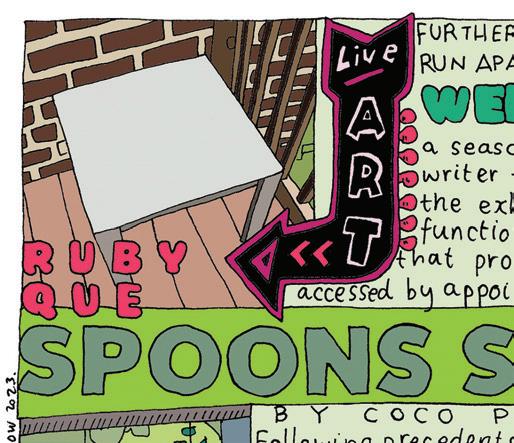



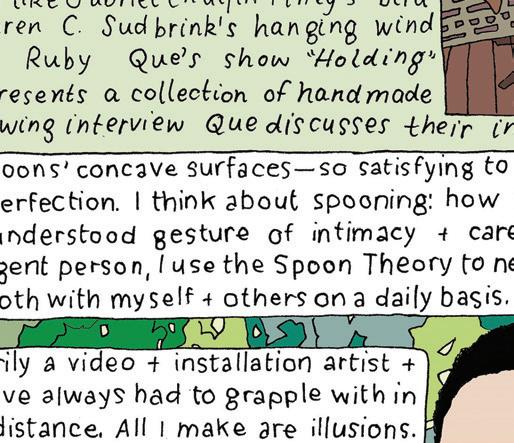



LITTLE SHOP OF HORRORS 8/30 -10/ 15 : Wed 1: 30 and 7 PM, Thu 7 PM, Fri 8 PM, Sat 3 and 8 PM, Sun 1 and 5: 30 PM; Wed 8/30 7 PM only; Paramount Theatre, 23 E. Galena Blvd., Aurora, 630 - 8966666, paramountaurora.com, $28 -$79
 By JACK HELBIG
By JACK HELBIG
was Once Upon a Mattress at Theo Ubique Cabaret Theatre, and that was lovely. And then I codirected Fun Home in Paramount’s Copley Theatre. And I did that with [Paramount artistic director] Jim Corti. And I’d never codirected before. And I actually think that was his first time codirecting too. And we just had a blast. My third was Best Little Whorehouse in Texas back at Theo Ubique Cabaret Theatre.
How much of being a director is being a good listener?
it’s really di cult to work in New York if you don’t have your [Actors’] Equity card and if you don’t have an agent, it’s also really di cult to work in Los Angeles in film and TV.” I knew that my college professor, Valerie Flower, had lived in Chicago a long time ago and she had done the cartoon Carmen Sandiego
being swept along in the tide, the story is running away with him. But the script tells us otherwise. Like he really makes some very conscious choices at the very top that are really violent and really selfish. He doesn’t express a lot of remorse. And even his relationship with Audrey [the woman he pursues] is interesting too. I keep asking, “Are you really seeing Audrey, or are you seeing who you hope Audrey could be for you?” I just think it’s really fun to explore it from that angle and also challenging, in that I gotta make sure that the audience still likes him, right? I want them to like him, but then they’ve gotta be uncomfortable that they like him.
Audrey is often portrayed as just a prize for Seymour. What is your take on Audrey?
Landree Fleming TYLER CORE
Until recently, Landree Fleming was best known as a comic actor. She has appeared in over 20 local productions, including stints at the Marriott Theatre, Drury Lane, Chicago Shakespeare, and Porchlight. But over the last year she has begun to branch out into directing. Last season Fleming codirected Paramount’s “Bold” series production of Fun Home with Jim Corti (for which the two were just nominated for a Joseph Jefferson Award). She is currently directing Paramount’s revival of Little Shop of Horrors. This interview has been edited for clarity and length.
Jack Helbig: So is Little Shop of Horrors your first directing job?
Landree Fleming: This is my fourth. My first
You bring together a group of people who are incredibly talented, and you watch them, and you see what they say and think and do, and then you kind of marry them all together. It’s hard to even explain, but sometimes when I’m acting or improvising, there is so much focus that needs to be present I don’t blink. And I think that’s with directing too. You need to be so focused and so immersed in what they’re doing so that you can hear when your gut is saying, “Uh-uh.”
When did you first become interested in theater?
I come from very theatery people on the matriarchal side of my family. My grandmother loved musicals; we would watch videos of them all the time. And my mother minored in theater in college. And she still sings and does shows at her church and stu . I went to a very small school called Messiah College [in Mechanicsburg, Pennsylvania]; they didn’t have a music theater major. They just had a general theater major.
How did you end up in Chicago?
I graduated and then I got an internship at Cincinnati Playhouse in the Park. Professional actors would come through for the shows. They would do workshops or lectures with us on Mondays. And so they really just gave us a lot of good advice. They would say, “You know,
So I came to Chicago but I didn’t even really audition for theater very much. The first year and a half that I was here I studied at iO. My first musical, and I think my very first show in Chicago, was a musical, actually, a sketch musical, called Never Have I Ever. It was a student musical at Second City. And then I did some sketch comedy and wrote some sketch comedy. I was just learning my craft. I love comedy, but we didn’t really have any [improv] classes like that in college. I am still taking improv classes now at the Annoyance.
I really love their comedy. It is always so specific and unique. I think what I love about [Annoyance] is that they encourage you to trust your gut and take care of that, and that will help you create the story, because your gut’s not going to steer you wrong. Comedy is such a puzzle, which is so fun.
The Annoyance is also a place I think of as being one of the first safe places in improv comedy for LBGTQ+ performers, and also for women.
Yes, you’re right. It is a very safe space for those communities. I belong to both, and I do really feel that.
Little Shop of Horrors has been done by lots of theaters over the years. How is your version di erent, or is it?
I think what’s different in our production is the way we’re approaching Seymour. I think he usually is presented as an innocent that’s
She’s certainly three-dimensional for sure in our version. We acknowledge the stakes. It’s not funny that she’s in an abusive relationship [with a sadistic dentist]. It’s awful. She has a history as a sex worker—she alludes to that later in the show—and yet she still has hope, she still is kind no matter what. Contrasting with Seymour, she doesn’t revert to any kind of violence to get where she wants to go. And then she finds agency in death. You know, she chooses that for herself. And our Audrey, Teressa LaGamba, finds heart in places I hadn’t seen before. Like she has a schoolgirl crush on Seymour that’s so charming and so fun to see.
There is an interesting connection actually between the Annoyance and Little Shop of Horrors, since Little Shop is based on a 1960 B movie directed by Roger Corman, and there’s this kind of a B movie-Corman-John Waters influence at the Annoyance. Though it’s brighter and not as cynical as a lot of stu at the Annoyance.
The original is actually kind of scary. I had some inklings of where to go with Seymour, but I wasn’t totally certain. But then Jack Ball came in for the audition, and there was one line, where he had this turn where he was bemoaning his situation [that he might have to feed his girlfriend to a man-eating plant]— “What am I gonna do?” And then he had this flip, where for a second he was enjoying it. He had this little smirk on his face when he talked about killing her. And I was like, “Oh! There it is! That’s it! That’s wild!” It was great! v m












Recent movie-watching months have included keeping up with the WGA and SAG-AFTRA strikes.
By KAT SACHS“People are like, ‘Well, is your job really all that important?’” says Chicago-based actor Christopher Meister, who’s been a member of the Screen Actors Guild (formally known as SAG-AFTRA after the merger with the American Federation of Television and Radio Artists in 2012) for more than 20 years. “Whose job did you watch the most when we were all out of work during the pandemic? It was ours, it was the actor.”
He has a point. I sure watched a hell of a lot of movies during the pandemic. And before the pandemic. And after. As has been the case for most of my adult life, I’ve also watched a lot of movies (and occasionally, some television) this summer. However, what’s been different this year is that, like many others, I find myself contemplating more about the individuals responsible for what I’m watching—both in front of and behind the camera. Similarly, this consideration extends beyond mere artistic appreciation; it now encompasses an enhanced recognition of their labor, all that goes into the magic of the movies.
This is, of course, due to the ongoing Writers Guild of America (WGA) and SAG-AFTRA strikes. On April 17, the WGA announced that an overwhelming majority of its members (approximately 98 percent!—Chicago has more than 100 members) had voted to authorize a strike. When the guild failed to reach an agreement with the Alliance of Motion Picture and Television Producers (AMPTP) and the deadline for a new contract passed, the strike went into effect at midnight on May 1 and a work stoppage began the next day.
The guild’s demands are extensive, certainly more than a layperson scanning the headlines can fully understand. In broad strokes, however, writers are seeking: increased residuals, specifically from streaming services, around which there are currently no set standards; higher minimum pay rates; minimums for
writer rooms, for episodic television, in particular, with specifications on the number of writers involved and their employment duration; and, most eye-catchingly, clarity about the future of artificial intelligence and how studios might utilize it instead of hiring real people.
“[A] new deal needs to be made with the new technology, which is streamers,” says Brett Neveu, local screenwriter, playwright, professor, and WGA East strike captain. “Like we did with DVDs back in the 2006–2007 strike.”
SAG-AFTRA followed suit in mid-July. Many of their demands are similar to those of the writers, with some industry-specific differences, such as those concerning self-taped auditions, hair and makeup equity, and even a clause that entitles performers “who must wear restrictive corsets or other binding costumes” to additional compensation. However, demands regarding streaming residuals and emerging technology remain at the forefront of popular consciousness.
“I make more o of my network shows than I did Apple, and those network shows I might do one or two episodes a season, if that,” says Meister, who, in addition to a recurring role as a prosecuting attorney on Dick Wolf’s One Chicago shows (Chicago P.D., Chicago Fire, Chicago Med, and Chicago Justice), costarred on the Apple TV+ show Shining Girls . “And they’re not even willing to meet us at the table.”
Local filmmaker Jim Vendiola is among many writer-directors who aren’t members of a guild but still feel solidarity with the striking writers and actors. He identifies similarities between how these strikes are perceived and other labor struggles in Chicago. “I’m in full support of these folks,” he says. “At the bare minimum, just, like, having a livable wage is obviously foundational to survival . . . and the narrative that’s being spun is not dissimilar to other union e orts, like the ones we see elsewhere and in Chicago, such as the CTU, right?”
“One of the most amazing things is solidarity with all the unions,” says Neveu. “[Chicago] is the home of the union. That’s been amazing, just to watch the Chicago Federation of Labor, the teachers’ union, the airlines, the steel workers, Teamsters, everybody is joining up. Because it’s essentially all the same fight.”
Meister spoke about how other industries involved in the filmmaking process could be affected, particularly concerning the issue of artificial intelligence. ”[AI] is a real threat to every aspect of the industry. Writers and actors are quicker to realize that than any-
one else, including the people who are often referred to as ‘below the line.’ If it affects a writer, it’s going to a ect an actor; it will have an impact on Teamsters, IATSE [International Alliance of Theatrical Stage Employees] members, catering . . . You don’t need those things if you don’t need a set.”
Meister continues, “This strike is significant. I anticipate it will last a long time. It might very well become the longest strike we’ve ever seen.” The record to break is six months; in the year 2000, members of SAGAFTRA, then divided into two groups, went on strike against the American Association of Advertising Agencies. Many will also recall the writers’ strike of 2007–2008, which greatly impacted the television landscape, specifically, and is considered a reason for the ongoing proliferation of reality TV programming.
Alongside the protests occurring in Los Angeles and New York, there have also been strike rallies here in Chicago. Both those involved and others not directly connected are naturally wondering what these strikes mean for the city’s recently thriving production industry. As noted by South Side Weekly in a recent article about the strikes, the Chicago Film O ce’s Current Production Information web page simply states, “Postings will be listed on this page when they are available. Please check back with us.” In July, Block Club cited a source who referred to Cinespace Studios as a “ghost town.”
“At least for the fall, things have come to a complete stop,” says Chicago-based SAGAFTRA actor Luigi Sottile. “For example, the Chicago shows.” Sottile has held roles on both Chicago P.D. and Chicago Med . “It’s a little nerve-racking,” he adds. “I’m definitely being more cautious with money . . . hopefully, if we come out of this, it will be for the better.”
While the implications may seem obvious for larger productions that rely heavily on union writers and actors (as Neveu, the strike captain, notes, most television productions were already shut down for summer, but those such as the One Chicago shows were ramping up to return and are now just waiting), smaller productions are also feeling the e ects.
“The strikes have completely altered the trajectory of my plans for this year,” says Vendiola, the local filmmaker. “I was in discussions about optioning a limited series I’ve been developing since the fall of 2021.” He continues, “I support the writers and the actors. The streamers hold everyone at their mercy; their lack of transparency is deeply concerning. But, at the same time, it’s incredibly disruptive to
have been on such a promising path, only to indefinitely shelve those plans.”
Chicago-based actor and independent filmmaker Emily Lape has aspirations to shoot her second feature in September. She applied for an interim agreement with SAG-AFTRA, specifically as an Ultra Low Budget Project, which is a film shooting entirely in the United States with a maximum budget of $300,000. “It reached the point where crew members contacted me and asked, ‘Is this project still happening? Our dates are set, should we proceed?’ They need to earn a living and secure some income, so we ultimately had to postpone it. We didn’t know when we’d hear from SAG, and it wasn’t fair to keep people in limbo over our shooting dates when we genuinely didn’t know if we could move forward.”
Overall, however, another local filmmaker, Michael Glover Smith, who’s also preparing to shoot a feature in 2024, highlights the benefits of these interim agreements. “What I find ingenious is how SAG is allowing independent filmmakers to utilize SAG actors. Essentially, they’re exposing the greed of the studios and streamers,” he notes. “It’s a fair way to provide people with work while also revealing the hypocrisy . . . of [the] major studios.”
He continues, “The ones who are su ering the most now are the ones who were already struggling the most before the strike started— the people who weren’t making much money.”
And what does all of it mean? “It shows that you need the workers to make the thing that you are selling to the people,” says Neveu. “As writers and the actors, too, we’re the people who make the things.”
As of this story’s writing, the WGA strike has shown some progress, with the WGA and AMPTP scheduled to meet for the fourth consecutive day after not having been in the same room since the strike began in May. On the other hand, the SAG-AFTRA strike remains stalled. A recent poll found that 67 percent of surveyed American voters support both strikes, and the message is clear: The strikers aren’t just asking for fair compensation and representation, but for respect—for their talent, skills, likeness, and most importantly, their jobs. It appears that some individuals may need to spend the remainder of their summer vacation learning just that.
“We’re no strangers to hard work,” says Sottile. “We’re no strangers to chomping at the bit and having multiple jobs in order to sustain [ourselves] so we can do what we love.” v
Get showtimes and see reviews of everything playing this week at chicagoreader.com/movies





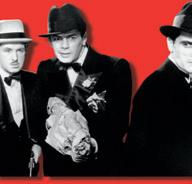





The kids may be under siege in the Chicago-made gem BAM!, but they’re less euphoric than dazed and confused, and the approach works out well for all involved. Throw in the economic urgency of some American honey, and the city’s legalization of the majority’s coping method of choice, and you have yourself a romp, the kind that flourishes under budgetary constraints.
Really, who needs cops to throw a wrench into things when you’re struggling to survive the gig economy? At least the broke, ragtag crew in American Honey had a somewhat steady source of income. But Auggie (Tuxford Turner)—the tender, beating heart of the interlocking stories unspooling in BAM!—can’t even afford a storage unit, and that’s before their bike gets stolen, ensuring that they can’t even make the paltry amount they were earning as a deliverer of goods for a local sex toy shop.

No wonder Gen Z is so desperately grasping for found family. It can be difficult for the olds to fathom how a bed for a night and a hair-braiding session can be lifesaving, or why a drug dealer (ahem, freelance pharmacist) can not only be an actual friend but a source of sanity. In the smartphone era, when people expect even their vices to be delivered right to their door at a set time, when said freelance pharmacist (Brandon Wright) leaves his roommates in charge while on vacation, it’s more than a mere comic relief subplot—it could cost him customers.
Good thing writer-director Jordan Tragash knows that no one should be defined by their incomes; there are also relationships that flourish against all odds and sweetly quiet moments of artistic contemplation, which are barely hampered by the at times awkward or too
visible camera work. There’s also a refreshingly casual diversity that ensures BAM! isn’t only a love letter to Chicago, with many landmarks only natives will recognize, but also one of the best examples of what talented artists can achieve when they refuse to take making art for granted. —ANDREA THOMPSON 80 min. Limited festival release
Blue Beetle starts out with a decent idea. Rather than focusing on billionaires and gods and kings and super soldiers, the hero of this narrative is instead a Mexican American first-generation college student with undocumented family members about to lose their rented home to gentrification. Jaime Reyes (Xolo Maridueña) is someone who really has something to lose—and something to gain—via superhero empowerment.
That potential, though, is almost entirely squandered. Jaime’s family is loud and loving as per ethnic

Hollywood default, but the movie never makes them much more than stereotypes. Instead, it tosses screen time at Jaime’s impressively sparkless relationship with billionaire-with-a-tragic-backstory Jenny Kord (Bruna Marquezine), and then at his equally uninvolving relationship with a blue symbiote alien supersuit, which bonds to his back and nervous system.

We somehow, over two hours, learn next to nothing about this blue whatsit super symbiote suit, except that it is all-powerful, which means it’s constantly filibustering and claiming to have to reboot, because otherwise it would just beat up all the bad guys and end the film in a blast of blue light and indifferent CGI. Eventually the supersuit does, and the film does, and the CGI does, but only a er Jaime has yelled at it a whole lot—demonstrating, if you were wondering, that a guy standing and screaming at his own silly outfit is neither dramatic nor visually absorbing.
The good news is that there is a recent idiosyncratic, smart superhero movie about family and togetherness. It’s called Encanto. I’d suggest watching it and skipping Blue Beetle entirely. —NOAH BERLATSKY PG-13, 127 min. Wide release in theaters
up for neither of their best work with Strays, a lackluster, crude dog comedy whose blessedly short run time is its most redeeming feature. (OK, the dogs are cute too.)
Reggie (Will Ferrell), a naive young terrier, is le by his dirtbag owner Doug (Will Forte) on the streets, miles from home. Ill-equipped to navigate the urban landscape, Reggie is fortunate to team up with Bug (Jamie Foxx), a street-smart Boston Terrier and his canine crew Maggie (Isla Fisher) and Hunter (Randall Park). While learning the ropes of life as a stray, Reggie sets off on his quest to make it back home and seek revenge on the thing that Doug loves most: his penis.
Strays utilizes some emotionally manipulative heartstring tugs here for our dog protagonists, particularly Reggie, who bears the brunt of an owner who truly deserves what’s coming to him, but nothing really lasting. Narratively, there’s a variety of messy situations our pack finds itself in to move the plot forward—run-ins with the canine law, psychedelic drug use, predator attacks—but no truly felt stakes. Comedy-wise, much of the attempted humor is an extension of, “Wouldn’t it be funny if dogs could swear, do drugs, or have sexual perversions?” There simply isn’t much new or interesting ground explored here in yet another variation on the “What if this cute thing was edgy?” trope. —ADAM MULLINSKHATIB R, 93 min. Wide release in theaters v
This
By BILL MEYERThe 2022 Chicago Jazz Festival was a heartening return to form for an event that hadn’t happened as usual since 2019. The weather held up, the crowds came out, and the programming did a fine job balancing a diversity of visions of what constitutes jazz. That success makes the conservatism of this year’s program doubly puzzling.

The festival runs Thursday, August 31, through Sunday, September 3, in Millennium Park and at the Chicago Cultural Center. And admittedly, the lineup checks plenty of important boxes. Student ensembles and young musicians will take their usual place on the Harris Theater rooftop early Saturday and Sunday—a vital acknowledgment of the players who will carry the genre forward. And the programming Thursday at the Cultural Center and Friday through Sunday at the Von Freeman Pavilion (on the park’s north promenade) includes singer and keyboardist Alexis Lombre; trombonist Jeb Bishop leading a quartet with trumpeter Russ Johnson, bassist Jason Roebke, and drummer Isaiah Spencer; and small groups revisiting classic music by Horace Silver, Wes Montgomery, Louis Armstrong, and Sidney Bechet.
The big names at Pritzker Pavilion include drummer Makaya McCraven, whose recent recordings reconcile the lushness of 70s film soundtracks with assertive hip-hop grooves; Dianne Reeves, a 2018 NEA Jazz Master, who will satisfy fans of vocal jazz; Chicago-born saxophonist Chico Freeman, who’ll celebrate the centennial of his father, Von Freeman; octogenarian bassist Ron Carter, who’s been involved in a vast swath of jazz history; singer Billy Valentine, who’ll draw on more than half a century of socially and spiritually conscious soul, gospel, and jazz; and Juan de Marcos & the Afro-Cuban All Stars, who’ll get folks on their feet for the customary party-oriented closing set.

Despite that wide variety, though, the history of jazz is much better represented than its potential futures—and that’s especially disappointing, because avant-garde bookings are usually such a strong point for the festival. The programming committee is a collaboration between the Jazz Institute of Chicago and the city’s Department of Cultural A airs and Special Events, and it currently includes author and Reader contributor Aaron Cohen. He assures me this year’s bill doesn’t reflect a shift in priorities. “Each year, the committee tries to balance performance idioms, generations, and instruments,” Cohen says. “We don’t book headliners who have headlined in the last five years.”
That said, the 2023 lineup doesn’t have a
paradigm-shifting figure on the level of past festival performers Ornette Coleman, Roscoe Mitchell, or Henry Threadgill. It gets close with 79-year-old Chicago saxophonist and pianist Ari Brown, an esteemed player who’s worked in avant-garde settings—and who’s also a member of the Association for the Advancement of Creative Musicians, which has supported Black musical self-determination since the 1960s. Brown has had a great year, working as a guest soloist with Joshua Abrams’s Natural Information Society and in a new trio with Abrams and drummer Mike Reed. But his Friday-evening Pritzker Pavilion appearance with his regular quintet will celebrate his own rich history rather than explore the directions he might still take the music in the future.
This year’s Jazz Festival does the most to honor the pursuit of transformation and reinvention that makes jazz a living art form by giving a Saturday-evening Pritzker Pavilion set to South African composer and pianist Nduduzo Makhathini. His trio consists of drummer Francisco Mela and bassist Zwelakhe-Duma Bell le Pere, and his music combines Zulu ceremonial forms and celebratory township grooves with a spiritual intensity inspired by John Coltrane’s A Love Supreme. The Cuban-born Mela, who appeared here as part of Experimental Sound Studio’s Option series earlier this month, drummed for pianist McCoy Tyner from 2009 till 2019, and more recently, he’s made electrifying free-jazz recordings with Zoh Amba, Matthew Shipp, and William Parker—he’s a living link to Makhathini’s American inspirations.
Every year, Chicago’s jazz clubs do their best to keep the festival vibe going into the night by hosting jam sessions and other concerts. And recently the Department of Cultural A airs and Special Events has partnered with local venues and organizations, via the Citywide Jazz Community Funding Program, to present free concerts around town in the days leading up to the fest.
One show of special note this year is an Elastic Arts set on Tuesday, August 29, by fearless free improvisers Extraordinary Popular Delusions, who’ll welcome the return of saxophonist Mars Williams after an eight-month hiatus for cancer treatment. And on Friday, September 1, Mike Reed’s Big Gig convenes a celebratory repertory band that will turn material by Duke Ellington, Sun Ra, Michael Moore, and Tobias Delius into a party at the Green Mill. I’ve collected some more highlights from outside the festival on the next page.
year’s solid lineup largely lacks the usual avant-garde artists, but plenty of daring satellite shows are still happening around town.
Thursday, August 24
Gary Bartz 8 and 10 PM, Jazz Showcase, 806 S. Plymouth Ct., $30, VIP $45, 21+
Friday, august 25
Gary Bartz 8 and 10 PM, Jazz Showcase, 806 S. Plymouth Ct., $35, VIP $50, 21+
Saturday, august 26
Gary Bartz 8 and 10 PM, Jazz Showcase, 806 S. Plymouth Ct., $35, VIP $50, 21+
Sunday, august 27
Gary Bartz 4 and 8 PM, Jazz Showcase, 806 S. Plymouth Ct., $35, VIP $50, 21+
Dave Rempis, Joshua Abrams, and Avreeayl Ra with Jim Baker 9 PM, Hungry Brain, 2319 W. Belmont, $10, 21+
Monday, august 28
Jazz Festival Citywide: Coco Elysses Elixir Ensemble With Alexis Lombre, Casper, Adam Zanolini, and Keya Trammel. 8 PM, Elastic Arts, 3429 W. Diversey #208, free, all ages
Tuesday, august 29
Jazz Festival Citywide: Extraordinary Popular Delusions featuring Mars Williams 8 PM, Elastic Arts, 3429 W. Diversey #208, free, all ages
Matt Ulery, Quin Kirchner, and Julius Tucker, followed by the Whistler Jam 8 PM, the Whistler, 2421 N. Milwaukee, free, 21+
Wednesday, august 30
Jazz Festival Citywide: Isaiah ^2 With Isaiah Spencer and Isaiah Collier. 8 PM, Elastic Arts, 3429 W. Diversey #208, free, all ages
Javier Red Quartet 8 and 10 PM, Jazz Showcase, 806 S. Plymouth Ct., $20, student $15, VIP $30, 21+

Thursday, august 31
Dave Rempis, Jason Adasiewicz, Joshua Abrams, and Tyler Damon 8:30 PM, Elastic Arts, 3429 W. Diversey #208, $15, all ages

A er Fest Jam Session hosted by Bobby Watson 9 PM, Jazz Showcase, 806 S. Plymouth Ct., $25, VIP $40, 21+
Friday, september 1
Reader print ad (runs Thu 8/24): Metro- 4 breakouts
A er Fest Jam Session hosted by Bobby Watson 9 PM, Jazz Showcase, 806 S. Plymouth Ct., $30, VIP $45, 21+
Murder by Death


Boris/Melvins
Fiddlehead
George Clanton
Mike Reed’s Big Gig With Greg Ward, Hunter Diamond, Keefe Jackson, Cole Degenova, and Christian Dillingham. 8 PM, the Green Mill, 4802 N. Broadway, $15, 21+
SB- 1 breakout
Ravinia Queen

Saturday, september 2
A er Fest Jam Session hosted by Bobby Watson 9 PM, Jazz Showcase, 806 S. Plymouth Ct., $30, VIP $45, 21+
Mike Reed’s Big Gig With Greg Ward, Hunter Diamond, Keefe Jackson, Cole DeGenova, and Christian Dillingham. 8 PM, the Green Mill, 4802 N. Broadway, $15, 21+
Sunday, september 3
A er Fest Jam Session hosted by Bobby Watson 9 PM, Jazz Showcase, 806 S. Plymouth Ct., $30, VIP $45, 21+
Ari Brown, Joshua Abrams, and Mike Reed 9 PM, Hungry Brain, 2319 W. Belmont, $10, 21+
Monday, september 4
Labor Day Festival 4 PM: Paul Wertico (drums), Scott Earl Holman (piano), Mark Neuenschwander (bass); 5 PM: Ari Brown (tenor saxophone), Matt Ulery (bass), Ted Sirota (drums), Jim Holman (piano); 6 PM: Sam Robinson (trumpet), Mark Neuenschwander (bass), Linard Stroud (drums), Jim Holman (piano); 7 PM: Eric Alexander (tenor saxophone), Tim Davis (drums), John Sutton (bass), Jim Holman (piano); 8 PM: Eric Alexander (tenor saxophone), Tim Davis (drums), Clark Sommers (bass), Jim Holman (piano), Jazz Showcase, 806 S. Plymouth Ct., $20, student $15, VIP $30, 21+ v
m letters@chicagoreader.com
ARC AFTER
All four evenings of the Jazz Festival end at Pritzker Pavilion. PATRICK L. PYSZKA, CITY OF CHICAGO

ARC AFTER DARK
METRO: Carl Craig x Moodymann / DJ Pierre
Dunn / CZBOOGIE
SMARTBAR: The Blessed Madonna b2b Jaq A aque / Ariel Zetina b2b Madeline
Two staggeringly prolific titans of the genre—saxophonist Chico Freeman and bassist Ron Carter—play backto-back at Pritzker Pavilion.
By STEVE KRAKOWWhen I looked over the lineup for this year’s Chicago Jazz Festival, the first thing that leaped out at me was the pair of sets at Pritzker Pavilion on Thursday—saxophonist Chico Freeman celebrating the centennial of his famous father, Von Freeman, followed by bassist Ron Carter leading his group Foursight.
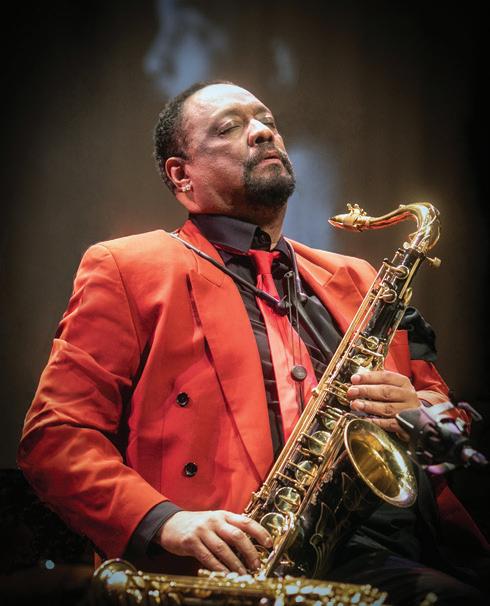
Freeman came up in the late 70s with the neo-traditionalist Young Lions (Wynton Marsalis, Roy Hargrove, Terence Blanchard)

but by the late 80s had launched an electric band called Brainstorm; Carter might be best known for the five years he spent in Miles Davis’s second great quintet in the 60s. But it’s only a slight exaggeration to say that between
the two of them, they’ve played with every single musician of note from the past half century of jazz, pop, Latin music, reggae, country, folk, soul, and beyond.
At 86, Carter has 12 years on Freeman, so if they were to compete on raw number of sessions, he’d surely win— Guinness World Records even recognized him in 2016 as the most-recorded bassist in jazz history, having played on 2,221 albums (“and counting,” Carter adds). If you were to set them head-tohead on variety of gigs, though, it’d be a wash: Freeman has played with the likes of Don Cherry, Bobby McFerrin, Celia Cruz, Hall & Oates, and Michael Jackson, while Carter’s credits include not just Miles Davis but also Aretha Franklin, Billy Joel, Alice Coltrane, As-
trud Gilberto, and A Tribe Called Quest.
Carter began on cello before picking up the bass, and Freeman played trumpet before adopting the saxophone as his principal horn. Both men take a spiritual approach to their instruments, and as distinctive as their styles are, they can fit into all sorts of musical visions.
These giants hardly need me to introduce them—especially Carter, who’s the subject of the 2022 feature-length documentary Ron Carter: Finding the Right Notes —but I can’t resist trying. Born in Ferndale, Michigan, and now based in New York City, Carter joined Chico Hamilton’s band in 1959, gigging with the drummer while pursuing a master’s degree. He made one of his first recordings on
the 1960 Eric Dolphy album Out There, and he says his wife at the time helped teach Dolphy how to cook.
Carter’s tenure with Miles Davis, from 1963 till ’68, was in the quintet with Herbie Hancock, Tony Williams, and eventually Wayne Shorter. He says Davis never told him to play or change a note, and that when they talked, the trumpeter never wanted to discuss the groundbreaking music they were making— they’d talk about boxing, Carter recalls, or the politics of Harlem.
“[Carter’s] playing was clean and clear and definitive,” Hancock told the New York Times last year. “He was always right in the pocket at just the right place. He knew which way to go, to make it not just an exciting listening and playing experience but one that opened doors to new possibilities.”
Carter would later appear on Blue Note LPs by Hancock, Shorter, and Williams, as well as on albums by a slew of other jazz titans, including Sam Rivers, Freddie Hubbard, Lee Morgan, and McCoy Tyner. He played soul with Roberta Flack, fusion with Hungarian guitarist Gábor Szabó, and practically every other kind of music known to humans. Carter insists that every session he did was equally satisfying—he won’t pick favorites, and he says they were all learning experiences.
Carter’s discography as a bandleader begins in 1961, but he didn’t launch the group he’s bringing to the Jazz Festival—the quartet Foursight, for this show with drummer Payton Crossley, tenor saxophonist Jimmy Green, and pianist Donald Vega—until decades later. The group mixes hard postbop with standards such as “My Funny Valentine,” though Carter prefers not to concern himself with such distinctions. “I’m not sure how you decide what’s traditional over hard bop—I don’t put those titles on my music,” he says. “I like that song [‘My Funny Valentine’], so if you find a better standard, send me the lead sheets, and I’ll compare it against ones I like to play.”
Carter doesn’t want to make predictions about Foursight’s set—he says he’d like to be surprised by it himself. Whatever he plays, he makes it his own (“That’s what I do, man”), and his quest to find the right notes will never end while he can still play. He’s excited to get back to jamming and practicing with other musi-
cians every night, for as long as the pandemic continues to permit that. Carter describes his own playing as “a sound that commands the undivided attention of listener and player,” and this performance ought to reward the audience’s full concentration.
Chico Freeman is similarly prolific and wide-ranging, and his musical family includes not just his father, Von, but also two famous uncles, guitarist George Freeman and drummer Eldridge “Bruz” Freeman. In the 1950s, those three brothers made up the house band at the Pershing Hotel ballroom in Woodlawn, where they famously backed the likes of Dizzy Gillespie and Charlie Parker.
Gillespie’s philosophy particularly inspired Chico. “We once did an interview together, and they asked, ‘What is jazz?’” he says. “Dizzy said it was the search for truth. I realized that’s what we’re all looking for—it’s about what you feel and what you want to express at that moment. Because yesterday is not a real thing, and neither is tomorrow—only now. That’s the only truth that’s real. That’s been my mantra.”
Freeman started at Northwestern University in 1967, where he added the saxophone to his arsenal in his junior year. And throughout his formal education, he learned from his father. “I just felt like every music is really the same,” he says. “My experience taught me that, because I was playing jam sessions with my father and learning that way. But I listened to a lot of Miles and Trane, Motown, and R&B. I even sang in groups when I was younger.”
In the 1970s, Freeman further expanded his musical palette working with pianist and composer Muhal Richard Abrams, founding president of the Association for the Advancement of Creative Musicians. “Straight out of college, I went right into the AACM,” he says. “Muhal was my mentor. He taught me composition, and I learned my whole big-band approach because I was in his. I took in everything, including how to improvise.”
Von Freeman had always encouraged Chico to have his own immediately recognizable sound, rather than copy anyone else. For this Jazz Festival set, Chico pays homage to the powerful and distinctive musical voice of his father, who would’ve turned 100 in October.
For what he’s calling the Von Freeman Centennial, Chico says he’s doing a loosely structured three-tiered program mapped onto three eras in his dad’s career. “I’m trying to capture as much as I can, within 50 minutes to an hour, of the journey that he and I took together,” he explains. The band includes George Freeman (now 96 years old), bassist Avery Sharpe, drummer Yoron Israel, guitarist Mike Allemana, vocalist Margaret Murphy, and vibraphonist and pianist Thaddeus Tukes.
The first part of Von and Chico’s journey began in the early 80s. Von was already well-loved in Chicago, but he didn’t travel much—so a fast-rising Chico, then living in New York, helped boost his dad’s international career by arranging his first gigs in the Big Apple since the 60s as well as his first trip to Europe. Father and son took several tours abroad together and collaborated on many albums, often working with Sharpe (a longtime McCoy Tyner sideman) and Israel (who’s now department chair of percussion at the Berklee College of Music).
The second part also began in the 80s, with Von’s long-running Tuesday residency at the New Apartment Lounge on the south side, which continued till the bar closed for renovations in 2010 (Von died in 2012 at age 88). Allemana and Murphy both played many of those famous jam sessions, which accounts for their presence here. The third part, Chico explains, is about the younger musicians his dad encouraged and tutored—Chico was among them, of course, and he’s likewise helped upstart players. Tukes, who grew up in Pullman on the south side and graduated from Northwestern in 2016, represents those generations.
Chico promises a combination of Von’s compositions and jazz standards, with a few surprises. He’s thrilled to be back in Chicago (he now lives in Switzerland), and he’ll return in mid-September to play the Hyde Park Jazz Festival, the Jazz Showcase, and the Green Mill. This Jazz Festival gig isn’t the only one honoring his father, either—he’ll play Von Freeman Centennial shows at the Green Mill too. “His voice was his own,” Chico says. “No one else sounded like him. So that’s my definition of timeless.” v
Part of the Chicago Jazz Festival. Fri 9/1, 12:40 PM, Von Freeman Pavilion (north promenade), Millennium Park, 201 E. Randolph, free, all ages
The pianist, singer, composer, and producer will share vivid, genre-blurring songs from her forthcoming debut album.
By HANNAH EDGARAt 26, Alexis Lombre has been a fixture on the Chicago jazz scene for more than a decade, and lately she’s begun making a mark further afield. She began as a teenage piano wunderkind, and she’s since played in the Great Black Music Ensemble (a project of the Association for the Advancement of Creative Musicians) and bands led by Jon Batiste, Makaya McCraven, Marcus Miller, and other eminences.

Last month, the pianist, composer, vocalist, and producer shared a bill with the Maria
Schneider Orchestra at Ravinia, and next month she’ll join nonpareil vocalist and AACM member Dee Alexander—another longtime collaborator—in an all-women music and dance project called Ancestors Reign at the Hyde Park Jazz Festival. Lombre is just as prodigiously talented when leading her own band, though, and she’s leaping into that role all over the city.
On Friday, September 1, her trio with drummer Samuel Jewell and bassist Brooklynn Skye plays the Chicago Jazz Festival. On Septem-
ber 16, she’ll debut a new suite at the Englewood Jazz Festival with a band that includes Jewell, bassist Junius Paul, and other artists to be announced. She took inspiration for the piece from her experiences with synesthesia, a condition that links stimuli across senses; Lombre, for example, powerfully associates sounds with specific colors. “My goal for that project is to help the audience connect the senses, so that maybe they could see what I see,” she says.
Lombre grew up on the south side, in Englewood, Hyde Park, and Grand Crossing. She started playing the piano at nine; by 12 or 13, she says, “I knew that was it.” The piano felt intuitive to her—obvious, even. Around the same time, she started studying with Willie Pickens, the inexhaustible Chicago piano virtuoso and pedagogue, and he remained a key mentor until his death in 2017.
“It worked for me because we’re both Aries, so we’re both direct and assertive. He’d [teach] like, ‘Watch me play this. . . . OK, now you play it,’” Lombre remembers. “I liked that because it was very straightforward.”
Lombre’s jazz education continued when she moved to Ann Arbor, Michigan, for college in 2015, but it took place mostly outside the classroom. Even before the move, she’d dipped her toes into the Detroit scene on a tip from two Chicago artists, drummer Clif Wallace and singer Meagan McNeal—they’d urged her to check out the Tuesday jam sessions at Cli Bell’s, a venerable downtown venue that hosts jazz most nights. Soon she began running her own regular jam at another long-standing venue, the nearby Bert’s Market Place, and she threw herself into Detroit’s jazz and gospel circuits.
At the time, Lombre rarely sang onstage, preferring to present herself as a pianist and composer in the straight-ahead mold. That approach bears fruit on her all-instrumental debut EP, Southside Sounds (2017), consisting mostly of original tunes she’d written in high school. But Lombre’s music since then has set her iridescent, soulful voice front and center—as will her first full-length album, a more expansive and genre-agnostic recording that’s due next year.
“For some reason, I always avoided singing
when I was younger, because I wanted to be ‘taken seriously’ as a musician,” Lombre says. “I didn’t have to be so austere in that choice. Mentors kept trying to get me to sing all the time, and I thought they were only asking me that because I’m a girl. But when I went to college and turned 18, I was like, ‘Man, I just love to sing!’”
Lombre’s as-yet-untitled album, which she’s also producing, has been gestating for a few years now. Where Southside Sounds was more of a tribute to Chicago’s jazz heritage, this new release turns inward, toward Lombre’s own musical world. That world touches on funk, R&B, gospel, and hip-hop via influences such as PJ Morton, Erykah Badu, and Hiatus Kaiyote. It will be her album-length debut as a singer, a role she teased in 2021 with the single “Come Find Me.”
“I think that’s what’s taking me so long to produce this project,” Lombre says. “I’m taking time to develop this instrument with the same seriousness that I’ve developed on piano.”
The album’s lyrics coalesce around themes of mental health and perseverance—front of mind for Lombre after a globally traumatizing few years. “Lotus,” one of the songs she’ll perform Friday at the Jazz Fest, is an accidentally prescient anthem of resilience that she wrote in high school but didn’t include on Southside Sounds . Another new tune, “Chaos,” arises from Lombre’s experience during the pandemic. “I wrote that about being an empath,” she says, “and feeling all the chaos all around you—making a pact to yourself that you will not let yourself lose your mind.”
Friday won’t be Lombre’s first stomp through the Chicago Jazz Festival grounds, though. In her teens, she frequently performed on the Young Lions stage, most recently leading a quintet there in 2016. But her billing this year, at the Von Freeman Pavilion, makes plain she’s no longer a precocious up-and-comer.
“I’m not even so hung up on genre. I just want to express myself,” Lombre says. “This album is showcasing myself as a vocalist, a producer, a composer, and a pianist. I want to come out as a main-stage artist.”
m letters@chicagoreader.com


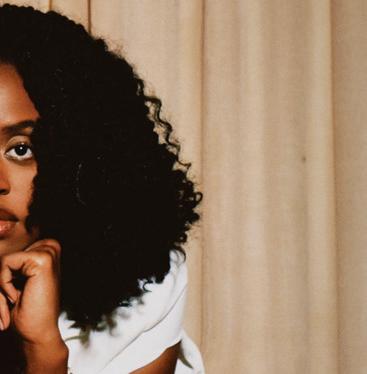


















Merce Lemon Lily Seabird, Hemlock, and Sleeper’s Bell open. 7:30 PM, Sleeping Village, 3734 W. Belmont, $14, $12 in advance. 21+
Merce Lemon makes gentle indie rock that’s generous in its honesty and forthright in its storytelling. Since she was a child, she’s been a staple of the Pittsburgh DIY music scene, playing in bands such as the punky Two Dragons Black and Red, which she le when she was 12. She stepped away from music for much of her teen years, but she returned in 2017 with her debut EP, Ideal for a Light Flow With Your Body . She’s since followed up with a second EP, 2018’s Girls Who Jump In , and her first full-length, 2020’s Moonth (on Los Angeles-based label Darling). Lemon’s work is o en held together with subtle band arrangements composed mostly of hushed guitar, drums, and bass, and its youthful charm recalls the early releases of indie-folk artists such as Frankie Cosmos and Florist. Her lyrics are thoughtful and straightforward, and they demonstrate her way of relating to the world with an infectious sense of gratitude and wonder. The aching murmur of Lemon’s voice, applied to her crystal-clear observations of life’s messy feelings, make it easy to hang on every word she sings. She seems to see things as they are, and her honesty draws you in.
One of my favorite songs on Moonth is “Dolly Sods Blues,” a melancholy, slightly washed-out tune with muffled drums and a gentle swirl of twinkling guitar (the latter played by Greg Pierce, Lemon’s bandmate and father). Lemon muses tenderly about nature and connection, and toward the end of the song she repeats the line “And my body carries more than I imagined it could do.” It’s this quiet assuredness that I appreciate most about her songwriting: though she’s still working her way through the challenges that come with growing older, she already has a magical way of helping you push past uncertainty and feel like everything is going to be OK.
—TASHA VIETS-VANLEARD2X,
Fri 8/25, 8 PM, Metro, 3730 N. Clark, $20, $15 in advance. b
CHICAGO RAPPER Demauris “D2x” Dixon performs like he insists on giving his absolute best to every facet of his life. Sometimes that pressure gets to him—when he races to squeeze a knotty, weighty lyric into an otherwise easygoing verse, for instance, he can disrupt his crisp fl ow and casual charisma. But there’s beauty even in Dixon’s missteps, which have the same kind of charm as the sampled and looped soul vocals on his new self-released second album, Hotel 1105—they’re both a little o the beat, with an endearing raggedness that suggests they move according to their own internal logic. This is an aspirational album, and in his refl ective lyrics, Dixon pores over his past in straightforward detail. He raps about his messy upbring-
ing and absentee father, hardships that have pushed him to excel on the mike and (as he points out throughout the album) work hard to achieve a comfortable living for himself and his loved ones. Part of what I enjoy about Dixon as an artist is that he clearly cares a great deal for the people in his life, no matter what he’s been through or how much hurt they’ve caused him. On “Dreams of an Adolescent,” Dixon describes his father as little more than a mirage in his life, then immediately delivers a blink-and-you’ll miss it line that changes the whole emotional color of the song: “I still love him, I just wish we had more memories to keep.” I hope the kindness Dixon shows throughout Hotel 1105 continues to animate his music. —LEOR GALIL
D2x See Pick of the Week at le . Rich Jones and Air Credits open. 8 PM, Metro, 3730 N. Clark, $20, $15 in advance. b
Chicago Cultivate day one See also Sat 8/26 and Sun 8/27. Crumb headline; Andy Frasco & the U.N., Lucky Boys Confusion, Murphy’s Law, Mac Sabbath, and Otnes open. 3-10 PM (gates at 2 PM), the Nursery, 1800 W. Lake, single-day ticket $49.98, three-day pass $99.98. 21+
Chicago Cultivate celebrates cannabis culture, specifically the longtime friendship between music and marijuana. The lineup at this three-day bud bash assembles elites from the worlds of reggae, hiphop, punk, and rock and adds sponsorships and vendors from some of Chicago’s best local brands. For obvious reasons, it’s a 21+ event, and though cannabis won’t be sold on-site, consumption is encouraged; CBD beverages will be available at the bar,
and audience members can commute via shuttle buses between the festival grounds and nearby dispensaries.
On the music front, Friday’s lineup includes super-eclectic rockers Andy Frasco & the U.N., Chicago land punky hard-rock faves Lucky Boys Confusion, New York hardcore lifers Murphy’s Law, and zany heavy-metal parody band Mac Sabbath. Among Saturday’s highlights are alt-hip-hop icons the Pharcyde, Swedish rockers Graveyard, garagerock veterans Black Lips, and midwest psychobilly rodeo swingers the Goddamn Gallows.
Sunday promises to be just as exciting: GZA of the Wu-Tang Clan will perform his quintessential 1995 album Liquid Swords with his live band the Phunky Nomads, “Because I Got High” singer and unlikely activist Afroman will blaze through, and alltime great ska-fusion band Fishbone will tear up the stage. World-renowned songwriter and producer Julian Marley (son of reggae icon Bob Marley) will bring his inspiring vision of Rastafarian culture to Cultivate, along with his band the Uprising. Consuming cannabis while making or listening to music is a tale as old as time; you might feel euphoria, increased focus, or increased connection to the sounds. Modern history is loaded with examples of the love affair between musicians and cannabis— reggae is deeply intertwined with Rastafarianism and its belief in marijuana as a sacred plant, 60s rockers embraced weed (and other drugs) along with psychedelia, and hip-hop artists have long celebrated blunts—and Cultivate is the perfect place t0 see that all play out. So stay hydrated, find a designated driver (or take public transit), and get li ed.
—CRISTALLE BOWEN
Chicago Cultivate day two See Fri 8/25. The Record Company headline; Graveyard, the Pharcyde, Black Lips, Brant Bjork, the Goddamn
Gallows, Dry Reef, and Oux open. 1:30-10 PM (gates at 1 PM), the Nursery, 1800 W. Lake, singleday ticket $49.98, three-day pass $99.98. 21+
Sara Curruchich Curruchich performs at 7 PM in the Tangled Roots Beer Garden on day one of LatiNxt. See Sun 8/27 for day two of the festival. From 2-11:30 PM, the lineup in the Beer Garden (in set order) is Future Rootz DJs, Mila La Morena, Cabeza de Chivo, Sara Curruchich, Las Cafeteras, and DJ Rosa Pistola.
From 2 PM-9:55 PM, the lineup on the Wave Wall Performance Platform is DJ Mateo, Eva Maria, Honey Lucio, and Pachanga DJs. Navy Pier, 600 E. Grand. F b
When Sara Curruchich makes her Chicago debut at the sixth edition of Chicago’s LatiNxt festival, the melodic syllables of the Kaqchikel Mayan language will ring out across Navy Pier for what might be the very first time. Curruchich is part a Kaqchikel Mayan community in Guatemala’s highlands, and she’s one of the first artists to compose and sing contemporary music in Kaqchikel.
Curruchich combines rock, folk, and traditional Kaqchikel Mayan music in her upli ing ballads. With grace and strength, her songs showcase her people’s long history of resistance and struggle, which came to international prominence during Guatemala’s civil war, which lasted from 1960 till 1996. Her fi ve-piece band combines lush, cascading marimba chords (played by the extraordinary Sandra Moreno) with steady guitar riffs, traditional percussion, and even kit drumming, all guided by Curruchich’s soaring, emotional voice. When I saw the group perform at the Indigenous Music Summit in Toronto in June, they stunned the audience into awed silence.
Curruchich’s 2019 debut album, Somos , and 2021’s Mujer Indígena center demands for dignity and respect for Indigenous women around the world; her anthems proclaim hope and make it

feel possible for me to believe in a different kind of future. As the band chant on the title track of Somos : “Somos vida, somos la historia y canción / Somos las venas de la tierra / La humanidad sin fronteras” (“We are life, we are the story and the song / We are the veins of the earth / Humanity without borders”).
—CATALINA MARIA JOHNSONNeptune’s Core Motel Breakfast headline; OK Cool and Neptune’s Core open. 7 PM, Metro, 3730 N. Clark, $20, $15 in advance. b
When Chicago teen four-piece Neptune’s Core formed in 2018, they wrestled with punk, indie rock, and power pop—sometimes it felt like they weren’t quite in control of their music, but the results were always at least interesting. They self-released their debut album, Can’t Have It All , in 2020, playing snaggletoothed melodies with enough feverish energy and raw determination to power them through their next decade as a band. Guitarists and vocalists Sofi e Richter and Jackie Cywinski steer Neptune’s Core, and their bandmates are also their sisters: Hannah Richter plays bass, and Kaitlin Cywinski plays drums. A er putting out the 2021 full-length Evolving on their own, Neptune’s Core hooked up with New York label Side Hustle (which released the terrific 2021 debut from Chicago rock act Waltzer) for the new EP Called Upon . The EP’s measured performances focus the frenzy of Neptune’s Core’s earlier work without sacrifi cing its charm—they’ve advanced dramatically in their handling of pacing and dynamics, making this their most accomplish release yet. “Inside” opens with tense rhythms and breathy vocals, so that the sustained, bell-like guitar chords that enter a er 45 seconds feel like the first fat drops of cold rain that precede a downpour—though they don’t quite prepare you for the rip-roaring full-band storm to come. “Inside” promises great things to come from Neptune’s Core, and I look forward to hearing them. —LEOR GALIL

Chicago Cultivate day three See Fri 8/25. GZA & the Phunky Nomads headline, performing the album Liquid Swords; Julian Marley & the Uprising, Earthless, Fishbone, Afroman, the Crombies, and Highball Holiday open, and Vic Mensa makes a special appearance. 1:30-10 PM (gates at 1 PM), the Nursery, 1800 W. Lake, single-day tickets $49.98, three-day pass $99.98. 21+
LatiNxt day two See Sara Curruchich on Sat 8/26 for more on the first day of the festival. From 2-9 PM, the lineup in the Tangled Roots Beer Garden (in set order) is DJ Itzi Nala, Linda Sol, Así Así, MULA, and DJ Mo Mami. On the Lake Stage in Polk Bros Park, Caramelo Haze play at 5:30 PM and Combo Chimbita play at 7 PM. Navy Pier, 600 E. Grand. F b
The Body Troller and Dead Times open. 8:30 PM, Sleeping Village, 3734 W. Belmont, $20.60. 21+
The Body’s music is a remorseless, seemingly eternal trudge of numbing night that frequently contorts itself into a bizarre festering eclecticism, then returns to its fetid, featureless form. Formed in Providence, Rhode Island, the duo of drummer and programmer Lee Buford and guitarist and screamer Chip King (who also supplies electronic weirdness) have proved ominously reliable in their 24-year commitment to doom, drone, noise, and art-metal. Their albums, such as 2021’s I’ve Seen All I Need to See (Thrill Jockey), feel like watching great black turrets fall on you in slow motion while dirt-stained nano-
continued from p. 37
bots puncture your eardrums. Despite the Body’s antisocial sonic vibes, though, the duo are also inveterate collaborators who seek out sympathetic nihilists with whom to huddle down in despair.
The Body’s most recent alliance was with Los Angeles post-industrial techno producer OAA (aka AJ Wilson) on 2022’s Enemy of Love (Thrill Jockey), which joined hammering beat loops and heady fuzz to their sludge. They’ve also worked with Canadian avant-metal trio Big|Brave, British dark ambient producer Haxan Cloak, and Providence a cappella ensemble the Assembly of Light Choir, among many others, swallowing new sensations and modes into their monochromatic sound the way darkness swallows light. This live set will feature just Buford and King, so audiences will know what to expect— though weirdness always finds a way of seeping in around the edges of their music. When you listen to the Body, you stare so intently into an utterly blank abyss that you start to see all manner of unspeakable things. While the end is inevitable, it always comes as a surprise.
 —NOAH BERLATSKY
—NOAH BERLATSKY
Ovef Ow This concert is a showcase for local label What’s for Breakfast? Records. Ovef Ow headline; Lollygagger and Sweetmelk open. 9 PM, Empty Bottle, 1035 N. Western, 21+. b
Local four-piece Ovef Ow have become darlings of Chicago’s indie-rock scene for their Farfisa- and guitar-driven hybrid of art-rock and punk. Their brand-new full-length debut, Vs. the Worm (released by local label What’s for Breakfast? and the band’s own Oort Clouds imprint), is a smart,

topical, danceable concept album that’s more or less about the band battling a slithering sciencefiction creature that acts as a metaphor for our uncertainty, angst, and existential crises. Like their idols, the B-52s, they use their upbeat rhythms and quirky lyrics in a way that o en seem to say, “If you can’t beat ’em, invite ’em to the party.” Frankenstein’s monster just wanted a little love and kindness—maybe that’s all Ovef Ow’s Worm wants too.
That’s not to say Ovef Ow don’t go for the jugular as necessary. The propulsive “MAD” faces down the threat of nuclear war and the sick joke that humankind could be sacrificed to the bruised egos of a couple of so-called leaders. With twinkling postpunk guitars and lush vocal harmonies, “Fauxtography” takes aim at how social media has supremely messed with the chronically online— especially their self-worth and concept of connection. And beneath the handclaps and catchy melodies of “Big Black and the Preacher” lies an indictment of the American carceral system and of religious hypocrites who divide people into “good” or “bad,” even while the “good’’ commit heinous acts. The title refers to two figures connected to New York’s Attica prison: Frank “Big Black” Smith, an inmate leader who was tortured by guards in the aftermath of the 1971 Attica uprising, and Gary “Preacher” Pritchard, a corrections officer who earned his nickname by reciting Bible verses before beatings and was named in at least 24 civil rights lawsuits filed by prisoners between 1994 and 2015. To celebrate Vs. the Worm , Ovef Ow headline a free What’s for Breakfast? label showcase at the Empty Bottle with local punk trio Lollygagger and Champaign outfit Sweetmelk. —JAMIE LUDWIG
Scorched Tundra XIII night one See also Fri 9/1 and Sat 9/2. Candy headline; Nicole Dollanganger and Without Waves open. 10 PM, Empty Bottle, 1035 N. Western, $27. 21+
This summer marks lucky 13 for Scorched Tundra, the smartly curated metal festival that Alexi Front launched in 2011 in Gothenburg, Sweden, and in 2016 began running in parallel in Chicago, which he considers Gothenburg’s metal-and-beer sister city. Though the pandemic clipped Scorched Tundra’s wings, it returned last year with a spectacular three-day lineup, and Front has kept his hand in the game since. In recent months he’s booked a couple of terrific one-off shows featuring the likes of Oregon cosmic-doom trio Yob and New Orleans sludge legends Eyehategod.
Front organizes Scorched Tundra’s lineups according to his ideas about contrast and blending, which also inform the palate he brings to the cra beers he makes to promote the festival. Scorched Tundra has partnered with various breweries over the years, and for this fest Front is bringing back the Metropolitan Brewing collaboration Humbucker Dortmunder, whose annual seasonal release fell earlier this month.
This year’s roster is a varied lot. Thursday opens with Candy, a five-piece formed in Richmond, Virginia, whose lushly violent 2022 album Heaven Is Here travels a twisty, surprising road through hardcore and progressive metal that takes swooping dives into shoegaze. Spooky chanteuse Nicole Dollanganger will bring down the volume but not the intensity, and local progressive-metal heroes Without Waves bring it on home with the night’s final set.
Friday features Indiana-based heavy shoegaze and space-rock trio Cloakroom, Ohio duo Osi & the Jupiter, whose neofolk style is the NordicAppalachian fusion you never knew you needed until you heard it, and punchy Chicago posthardcore group Luggage (featuring Reader contribu-
tor Luca Cimarusti), who drop a new album, Hand Is Bad , on September 29. Saturday is the biggest night, with four bands—fierce Austin trio Portrayal of Guilt, who fuse hardcore, metal, and screamo, headline the show, with support from Swedish stoner-doom power trio Firebreather (the only Swedish band this year) and untamed Olympia punks Gag. The strangest band on the bill plays first: Ak’chamel, a fascinating, trippy Texas act who built up their mysterious reputation with unholy invocations released on cassette. On their first vinyl release, the March 2020 LP The Totemist, they called themselves Ak’chamel, the Giver of Illness, and on this year’s A Mournful Kingdom of Sand , they’re going by Ak’chamel, the Cheek and Jowl Swollen Lymph Nodes. They describe themselves as “fourth world post-colonial cultural cannibalists,” and their music blends field recordings with influences from the Middle East and Africa. They’ve written music inspired by (and have performed in) a ghost town in the Chihuahuan Desert and an abandoned hot springs bathhouse in California, and they employ occult and gnostic themes to disorient and reorient the listener.
—MONICA KENDRICKARC Music Festival day one See also Sat 9/2 and Sun 9/3. Friday’s lineup includes Nina Kraviz, Colette B2B DJ Heather, Dalton Taylor, Boys Noize, Cassy B2B Toni Varga, and Eric Prydz presents Holo. 2-10 PM, Union Park, 1501 W. Randolph, $149 Friday general admission pass, $199+ Friday VIP pass, $389 three-day GA pass, $569+ three-day VIP pass. 18+
By halfway through the summer, I’m reliably burned out on music festivals, and lots of them I wouldn’t attend even if I were still in tip-top shape. So you know that a festival is special if I’m willing to tell you to spend one of your dwindling number of precious summer weekends paying to hang out with thou-
Natural Information Society headline the second night of Plantasia on Monday, September 4.
sands of people in a fenced-off public park. And the third-annual ARC Music Festival is definitely special. The three-day extravaganza brings more than 70 dance acts to Union Park, and the lineup is so saturated with talent you could easily overlook a big fish. I don’t even know how many times I stared dumbfounded at the bill before I noticed that it included a live set by Chicago acid-house pioneers Phuture, a rare treat—according to the mostly reliable listings at electronic-music portal Resident Advisor, the last time Phuture performed in Chicago was at SummerDance in 2015. When I study the festival schedule, my eyes bounce from South African house superstar Black Coffee (on Sunday) to Berlin-based South Korean dance-pop artist Peggy Gou (also Sunday) to Detroit deep-house whisperer Moodymann (who plays back-to-back with second-wave techno leader and fellow Detroiter Carl Craig on Saturday). ARC has booked plenty of dance-music legends, and the festival didn’t have to look far to find Chicago house veterans such as Derrick Carter, Gene Farris, Chosen Few crew members Mike Dunn and Terry Hunter, and three-fourths of long-running supergroup Superjane (DJ Lady D, DJ Heather, and Colette). Most festivals I’ve attended have lulls when I can rest and recharge because I’m uninterested in the programming, but from what I can see that won’t be the case at ARC. If I can find the energy, this is going to be a hell of a finale to my summer festival season. —LEOR GALIL
Scorched Tundra XIII night two See Thu 8/31. Cloakroom headlines; Osi & the Jupiter and Luggage open. 10 PM, Empty Bottle, 1035 N. Western, $27. 21+
Hungtai, Black Duck, Desert Liminal, Temp., and Isaiah Collier & the Chosen Few open. 5:30 PM, Garfield Park Conservatory, 300 N. Central Park, $45 per day, two-day passes sold out. 18+
Time has only deepened the music community’s affection for Mort Garson’s 1976 flora-themed synth spectacular, Mother Earth’s Plantasia. In celebration of Garson’s enduring legacy, Empty Bottle Presents and Brooklyn label Sacred Bones have created a festival of lush sights and sounds at Garfield Park Conservatory. For the event’s fourth iteration, they’ve expanded Plantasia into a two-night affair in Chicago, followed by an auxiliary event at Brooklyn’s Green-Wood Cemetery on September 14.
ARC MusiC Festival day TWO See Fri 9/1. Saturday’s lineup includes the Blessed Madonna, Fisher B2B Loco Dice B2B Nic Fanciulli, Ilario Alicante B2B Dennis Cruz, Moodymann B2B Carl Craig, John Summit, Phuture (live), and Fatboy Slim. 2-10 PM, Union Park, 1501 W. Randolph, $149 Saturday general admission pass, $199+ Saturday VIP pass, $389 three-day GA pass, $569+ threeday VIP pass. 18+

Scorched Tundra XIII night three See Thu 8/31. Portrayal of Guilt headline; Firebreather, Gag, and Ak’chamel open. 9 PM, Empty Bottle, 1035 N. Western, $27. 21+
ARC MusiC Festival day three See Fri 9/1. Sunday’s lineup includes Black Coffee, Vintage Culture, Hiroko Yamamura, Derrick Carter, Tale of Us, and Peggy Gou. 2-10 PM, Union Park, 1501 W. Randolph, $129+ Sunday general admission pass, $189+ Sunday VIP pass, $389 three-day GA pass, $569+ three-day VIP pass. 18+
Alex Zhang Hungtai Hungtai performs as part of the first night of Plantasia. See Mon 9/4 for details about the second night of the festival. Laraaji headlines; Jeremiah Chiu, Alex Zhang
The big draws at Plantasia’s local installment include headlining sets from new-age pioneer Laraaji (night one) and transcendent Chicago minimalists Natural Information Society (night two). But the artist I’m looking forward to most is Alex Zhang Hungtai, perhaps best known for the greasy grooves he made under the name Dirty Beaches. Since dissolving that project in 2014, Hungtai has shifted his focus to experimental music for voice and saxophone, though he’s made detours to appear in the relaunched Twin Peaks (where he was cast as a member of roadhouse band Trouble— not to be confused with the Chicago doom- metal legends) and play in cinematic drone trio Love Theme. According to EBP cofounder Brent Heyl, Hungtai’s set will be inspired by his current Montreal residency with Jerusalem in My Heart’s Radwan Ghazi Moumneh, during which he’s explored the spiritual subconscious with saxophone and keyboard.
The weekend’s bounty of performances will also recontextualize Garson’s work within Chicago’s improvisational music contingent, including radically diverse sets from Black Duck, Daoui (Angel Bat Dawid and Oui Ennui), and Isaiah Collier & the Chosen Few. While each artist will leave their own imprint on Garson’s work—Natural Information Society will offer rapturous repetition, Desert Liminal will weave a celestial haze, Surgery Boys will chop and screw MIDI patches into blissful oblivion—the sets will be unified by a reverence for his indelible impact on ambient music. Making this year’s Plantasia lineup extra special is the sharing of artists by the New York City and Chicago events: Hungtai, Daoui, and others will perform in both cities. In the near half century since its release, Plantasia has become a testament to the fact that art does not cease to grow after its creation—its listeners continue to germinate its seeds, breeding new life for years to come.
—SHANNON NICO SHREIBAKPlantasia night two See Alex Zhang Hungtai on Sun 9/3 for more on the first night of Plantasia. Natural Information Society headline; North Americans, Daoui (Angel Bat Dawid and Oui Ennui), Quin Kirchner, Jason Letkiewicz, Dustin Laurenzi, and Surgery Boys open. 5:30 PM, Garfield Park Conservatory, 300 N. Central Park, $45 per day, two-day passes sold out. 18+. v
FRIDAY, SEPTEMBER 8 8PM
Allstars In Maurer Hall
Kevin Johansen and Liniers In Maurer Hall
THURSDAY, SEPTEMBER 14 7:30PM
Frances Luke Accord with special guest Liz Chidester In Szold Hall
SATURDAY, SEPTEMBER 16 8PM
Lucy Kaplansky In Szold Hall

THURSDAY, SEPTEMBER 21 8PM
Clem Snide In Szold Hall
THURSDAY, SEPTEMBER 21 8PM
Big Bad
Voodoo Daddy In Maurer Hall
SATURDAY, SEPTEMBER 23 8PM
Tom Paxton & The DonJuans In Maurer Hall
THURSDAY, SEPTEMBER 28 8PM
David Longstreth
(of Dirty Projectors)
with Sen Morimoto In Maurer Hall
The Hurricane Trio featuring Chris Collins
9/13 Pibo Márquez
9/20 Riau Rhythm
9/27 Al-Qasar - World Music Festival Chicago 2023
MON 10/9
Kneecap 8 PM, Beat Kitchen, 17+
WED 10/11
Reneé Rapp, Alexander 23, Towa Bird 8 PM, Aragon Ballroom, 17+
WED 10/18
John Mayer (solo), JP Saxe
7:30 PM, United Center b
THU 10/19
Ann Wilson & Tripsitter
7:30 PM, the Vic, 18+
FRI 10/20
BCMC, Sam Prekop 9:30 PM, Hideout
Carl Cox, Anna, Chachi Guerrero, Christopher Coe, Derrick Carter, and more
10 PM, Radius Chicago, 18+ Vagabon, Nourished by Time
9 PM, Lincoln Hall, 18+
SUN 10/22
THU 9/7
Diners, Rust Ring, Mairy 8 PM, Beat Kitchen, 17+
FRI 9/8
Billy Childs, Rufus Reid, and Steve Wilson; Kurt Elling 7:30 PM, Martin Theatre, Ravinia, Highland Park b
SAT 9/9
Fjaak, Hyperactive, Jason Patrick 10 PM, Metro Queen! featuring Ron Trent, Shawn Christopher, Derrick Carter, Michael Serafini 5 PM, Carousel Stage, Ravinia, Highland Park b Shades of Blue featuring the Aqil Brothers, DJ Spincycle, and more 2 PM, South Asia Institute F b
SUN 9/10
Fiesta Ravinia featuring Reik, DJ Chava, Mariachi Bravo Waukegan, and more 2 PM, Ravinia, Highland Park b
Kevin Johansen & Liniers 7 PM, Maurer Hall, Old Town School of Folk Music b
MON 9/11
Dead Lucid, Vinyl Palace, Chinarose 9 PM, Empty Bottle F
WED 9/13
Impromptu Fest presents Mark Nagy & Station 4, the _ _ _ _ _ Experiment, Juliann Wang Collaborative 7 PM, Elastic F b
THU 9/14
Elastic Aural Mexico City x Chicago Exchange featuring Remi Álvarez, Gustavo Nandayapa, Alfonso Muñoz,
WED 11/8
Arch Echo, Stellar Circuits

8 PM, Beat Kitchen, 17+ El Khat 9 PM, Empty Bottle
THU 11/9
Angel Dust, Candy, Bib, 9Million 7 PM, Metro, 18+
Walter Etc., Suzie True, Xyzxyz 8:30 PM, Sleeping Village
SUN 11/12
Dying Fetus, Acacia Strain, Despised Icon, and more 6 PM, Concord Music Hall, 17+

Arturo Báez, Natalia Perez, Paul Giallorenzo, Adam Zanolini, Angel Bat Dawid, Lia Kohl, Katie Ernst, and Ben LaMar Gay 8:30 PM, Elastic b
Inferno featuring Bad Acid 303, Flores Negras, Conflict Bureau, Patrixia 10 PM, Smart Bar
Alex Mali 8 PM, Schubas, 18+
FRI 9/15
Bay Ledges, Mishegas 8 PM, Subterranean, 17+
Pup, Snotty Nose Rez Kids 10 PM, Concord Music Hall, 17+
SAT 9/16
Fantasia, Raheem DeVaughn 8 PM, Chicago Theatre b
Thursday, Braid 11 PM, Metro, 18+
SUN 9/17
Danzig, Behemoth, Twin Temple, Midnight 7 PM, Aragon Ballroom, 18+
MON 9/18 8-bit Creeps, So Speaker 8:30 PM, Hideout
FRI 9/22
Front Bottoms, Vundabar 8:30 PM, Aragon Ballroom, 17+
SAT 9/23
Fit for a King, the Devil Wears Prada, Counterparts 6:30 PM, Radius Chicago b
Prizefighter, Giving Moon, Drugstore Cowboy, Dead Lucid 7 PM, Bottom Lounge, 17+
THU 9/28
Motherland featuring Bonita Appleblunt, Icey Bby, Shadow Realm 10 PM, Smart Bar
FRI 9/29
Joan Osborne 8 PM, SPACE, Evanston b
SAT 9/30
Canadian Rifle, Nightmarathons, Distants, Two Houses 9 PM, Gman Tavern
SUN 10/1
Miko Marks 7 PM, Szold Hall, Old Town School of Folk Music b
Red Pears, Mexican Slum Rats, 60 Juno 6:30 PM, Lincoln Hall b
TUE 10/3
Frankie Cosmos, Good Morning, Joey Nebulous 9 PM, Empty Bottle
WED 10/4
Afrofuturist Weekend 8
Kickoff featuring Shanta Nurullah and more 6 PM, Fourtune House F b
Devendra Banhart, Le Ren 8 PM, Thalia Hall, 17+
Ringo Starr & His All Starr Band 7:30 PM, Chicago Theatre b
FRI 10/6
Handsome Family 8 PM, Maurer Hall, Old Town School of Folk Music b
SUN 10/8
Blind Boys of Alabama 7 PM, Maurer Hall, Old Town School of Folk Music b
Myke Towers 8 PM, Rosemont Theatre, Rosemont b
Snõõper, Citric Dummies, Cruelster, Consensus Madness 9 PM, Empty Bottle
Corky Siegel’s Chamber Blues 7 PM, City Winery b Thievery Corporation, DJ Shadow, Cosmic Trigger
7:30 PM, Radius Chicago, 18+
WED 10/25
Codefendants 8 PM, Reggies Rock Club, 18+ Michael Minelli, Tony22 8 PM, Schubas, 18+
THU 10/26
Deeper, Mia Joy, Lawn
8:30 PM, Thalia Hall, 17+ Scott Ligon’s All Star Freakout 8 PM, FitzGerald’s, Berwyn
FRI 10/27
Donna the Buffalo 8 PM, SPACE, Evanston b
SUN 10/29
Mike Dimes, Dro Kenji, Sid Shyne, Metro Marrs, Elz the DJ, DJ Cinco, and more 7 PM, Bottom Lounge, 17+
THU 11/2
Noah Floersch 8 PM, Schubas, 18+
Wynonna Judd 7:30 PM, Rosemont Theatre, Rosemont b Tyla Yaweh 8 PM, Reggies Rock Club, 17+
FRI 11/3
Del McCoury Band 8 PM, FitzGerald’s, Berwyn
Tritonal, Morgin Madison, Farius 10 PM, Concord Music Hall, 18+
SAT 11/4
Nadas, Emma Butterworth
8:30 PM, Reggies Music Joint
MON 11/6
Weedie Braimah 8 PM, City Winery b
Gold Panda, Shrimpnose 8 PM, Lincoln Hall, 18+
Odeya Nini 8:30 PM, Constellation, 18+
SAT 11/18
Nathan Graham, Phillip Michael Scales, Nettes 9 PM, Sleeping Village
Liz Phair, Blondshell 8 PM, Chicago Theatre b
TUE 11/21
Depresión Sonora 8 PM, Park West, 18+
Speedy Ortiz 9 PM, Empty Bottle
WED 11/22
Jazmin Bean 7:30 PM, Subterranean b
TUE 11/28
Crash Test Dummies 8 PM, SPACE, Evanston b
SAT 12/2
Mae, Tedious & Brief, Hembree 7:30 PM, Bottom Lounge b
Reverend Peyton’s Big Damn Band, Hooten Hallers
8:30 PM, FitzGerald’s, Berwyn San Pacho 10 PM, Prysm Nightclub
FRI 12/8
Motherfolk, Kevin Devine 8 PM, Subterranean, 17+
TUE 12/12
Ariel Posen, Brittany Kennell 7 PM, Sleeping Village
FRI 12/15
El Alfa 8 PM, Rosemont Theatre, Rosemont b
SAT 12/16
Flatliners 7 PM, Bottom Lounge, 17+
SUN 1/14/2024
Allison Russell 8 PM, Thalia Hall, 17+ v

IT’S BEEN YEARS since the duo of Tim Kinsella and Jenny Pulse (aka Jennifer Polus) dropped the name “Good Fuck” and began recording and performing under their own names. Their industriousness remains undiminished: they began developing the new Giddy Skelter , their debut full-length for Kill Rock Stars, nearly three years ago, and they made a lot of extra work out of it. They thought they’d finished mixing 18 months ago (when they started playing the songs live), and then they cut it down and self-released part of it last year. They kept rerecording, fussing, and twiddling, even releasing a zine about their protracted process nine months ago. The album finally comes out Friday, September 8, and it’s worth the wait—early singles “Nena,” “Whinny,” and “Unblock Obstacles” create a lustrous mix of psychedelic drone, fuguelike piano, and sweet AOR soul. Kinsella and Pulse celebrate with a release show at the Empty Bottle on Saturday, September 9, playing just before headliners Hide . The rest of the bill consists of Cube, the Ineffectuals, and DJs Club Drippy and Raudy.
One of Gossip Wolf’s favorite end-ofsummer parties returns this weekend! On Sunday, August 27, DJ Clent hosts his annual Beatdown House Litnic , and this time he’s using it to celebrate his label’s 25th anniversary. He’s put together a hell of a lineup of footwork, juke, and ghettohouse artists to do it: the stacked lineup includes his son DJ Corey , DJ PJ , King AGee , DJ Puncho , and DJ Roc . The Litnic runs from noon till dusk in Dolton Park (Evers and E. 147th), and it’s free!
You might know Debbie-Marie Brown from their work as the Reader’s social justice reporter, but they’re a hell of a musician too. They play rootsy indie rock with care, precision, and a bit of emo frenzy. But don’t just take this wolf’s word for it—you can see Brown yourself when they headline Beat Kitchen on Wednesday, August 30. Cusp and the Permanent Fix open. —J.R. NELSON AND LEOR GALIL
Got a tip? Tweet @Gossip_Wolf or email gossipwolf@chicagoreader.com.


I like you a lot but I am not ready to get a cat with you.
By DAN SAVAGE
Q: I’m a man in his 40s and my partner is in their 30s and nonbinary. We’ve been together for three years and officially living together for about a year. Things have been a little tumultuous during that time, due to issues with my kids, my kids’ mom, and my own fears about compatibility and commitment. She (my partner) is demanding “relationship milestones” that signify my commitment to her. Previous significant milestones, like becoming official, moving in together, her meeting my kids, etc., were “sullied” (and are therefore invalidated somehow) because they weren’t executed with enough “enthusiasm” or “careful planning.”
I would very much like to give her the milestones she craves, but aside from popping the question (and I’m definitely not ready for that!) I’m struggling to come up with “milestones” that would be of sufficient significance. And when I ask for examples, all I get are ideas I’m not ready for, like getting married or getting a cat. —MOVING IN LACKED EMOTIONAL SIGNIFICANCE
a: First and most importantly: the pronoun situation. You open by identifying your partner as nonbinary but then go on to use she/ her pronouns in reference to your partner throughout the rest of your letter. Since you’ve been seeing this person for three years—and since this nonbinary person doesn’t strike me as the kind of nonbinary person who would let misgendering slide—I’m gonna assume your partner is one of those nonbinary AFAB persons who uses she/her pronouns. They’re out there, they’re totally valid, they like to keep us binaries on our toes.
With that out of the way, the person you’re dating— the person you’re living with—doesn’t sound like someone who is easily satisfied.
Becoming official fell short of their expectations, meeting your kids wasn’t magical enough, there wasn’t a 21-gun salute or whatever they expected when you moved in together. There’s definitely a pattern here, MILES, and it’s a worrying


one. Meaning, I have a hunch your marriage proposal, if and when you decide to propose, will be another disappointment. The setting won’t be romantic enough, the diamond won’t be big enough, the choreography for the flash mob won’t be flashy enough. Then something will go wrong at the wedding, forever sullying their memories of it. They’ll find a reason to be disappointed by the honeymoon, the cat won’t be the right color, and on, and on, and on.
Actual life experiences rarely live up to our idealized

fantasies and someone who can’t focus on the good—someone who can’t take almost or close enough for an answer—will never be satisfied. There are some people out there who don’t want to be satisfied, MILES, and I suspect your partner is one of those people. If constantly finding fault and expressing disappointment means you’re always having to make things up to them, MILES, they’re never going to be satisfied with anything. Because their ability to point out the sullying detail gives them
power over you. In fairness to your partner, MILES, there’s nothing unreasonable about wanting to be married after three years together. But life is messy and chaotic. Life with a divorced man with children from a previous relationship comes with more mess and more chaos, and an understandable reluctance to remarry. Consequently, a divorced man with kids isn’t an ideal partner for someone who requires perfectly executed grand romantic gestures to be made happy—
assuming they can be made happy— and someone who requires perfectly executed grand romantic gestures isn’t an ideal partner for a divorced man with kids.
P.S. Another hunch: if they’re the kind of person who talks about their “birthday week” or, God forbid, “birthday month,” run. There’s no pleasing those people. v
Ask your burning questions, read full columns, and more at the URL savage.love. m mailbox@savage. love








PROFESSIONALS & SERVICES AUDITIONS COMMUNITY MATCHES ADULT SERVICES
Sales/Biz Dev Representative-Chicago
Reader Sales representatives sell print, digital, and ad products to local businesses. Sales reps shoudl have 2 years of sales experience OR similar skills, & knowledge of media/advertising products. Ideal candidates will be familiar with CRM software & GSuite. Comp packages vary (full or part time), & include salary, commission, and health benefits. Diverse candidates encouraged to apply. This is an ongoing search. Send a resume to careers@chicagoreader. com.
Copy Editor- Chicago Reader Chicago Reader is hiring a Copy Editor responsible for reviewing/revising content for accuracy & quality. Candidates should have a high level of accuracy/ attention to detail w/ exceptional written communication skills. 1 year of experience copy editing, proofreading, & fact checking, preferably for a media outlet, is required. Salary: $45-$50K. Benefits= Medical, dental, vision, PTO. Apply: http://chicagoreader. com/careers.
Barber and Stylist Gold Coast salon located on lake shore dr. is looking for a stylist and or barber to join their family. We are open Tuesday and Saturdays 8-4 and Wednesday thru Fridays 8-6, closed Sunday and Mondays. Rental and commission options are available. For more information call Kelli or Chris at 312-664-8710.
Senior Product Manager – Journey (League Corp) (Chicago, IL): Propose recommendtns; Train jrs; Bld teams & coordnt initiatives; Guide teams thru selectg opportunities & validtg sltns, ensure team is running effcnt dscvry that dlvrs on value & lvrgs wrk of others; Maintn projct status & reports, utlz Jira to prvd vsblty & communicate escltns, risks, dependcs & rslv; Gather & structr feedbck; Syntszs User Rsrch for insghts & use dscvry prcss & insghts to ID opportnts & dvlp hypothesis to shape projcts. Exp reqd: Prodct mgmt exp shippng tech; Exp in hlth-tech; leadg aspects of prdct mgmt from ideatn to launch, w/ fcs on imprvg metrics; Knwlg of data, anlytcs & visualztn; Exp wkg w/ Jira & Data Anlytcs Tools (Tableau, Looker, Amplitude); Exp leadg teams; partnerng w/ dsgn teams & guidg UX; craftg Prsnlzd Hlthcare exps; Undrstnd Agile dvlp prcss; Undrstnd & exp wrkg w/ patients w/ cmplx condtns; Exp wrkg at top US payer &/or prvdr; Exp communctg & presntg data. Reqs Bachelor’s or frgn equiv in Econ, Statistcs, Business
Intelligence or rltd fld, & 4 yrs exp as Prodct Anlyst or rltd. Optn to WFH avlbl. Trvl reqd – 1x quartrly to HQ in Toronto, CAN. Itnrt Emplymt - may be rqd to wk at vrs unantcptd lctns thruout U.S. Incdtl trvl may be reqd to clients in U.S. Salary: $139,568 - $189,700/yr. Send C.V. to mwebster@ league .com
Periodontist Professional Dental Alliance (Downers Grove, IL) seeking Periodontist to provide specialized care in the prevention diagnosis and treatment of periodontal disease including periodontal and implant cases, as well as prevention education.
Requires DMD/DDS degree or related (foreign equivalent accepted) from an accredited college or university, Certification in Periodontics from ADA accredited periodontology residency program, and valid IL dental license. Send cover letter and resume to Brittney O’Donnell, HR Business Partner, 125 Enterprise Drive, Ste 200, Pittsburgh, PA 15275
TECHNICAL
Cisco Systems, Inc. is accepting resumes for multiple positions in Chicago, IL: Software
QA Engineer (Ref#: CHI104C): Debug software products through the use of systematic tests to develop, apply, and maintain quality standards for company products. Telecommuting permitted. Technical Project Manager (Ref#: CHI416C): Coordinate small, medium, large/ complex and multiple projects throughout the project lifecycle (initiate, plan, execute, control, close) or a portion of a larger, more complex project. Telecommuting permitted. Technical Training Specialist (Ref#: CHI189C): Develop compelling technical content for various training programs and deliver training sessions on company’s technical products. Telecommuting permitted. Please email resumes including position’s reference number in subject line to Cisco Systems, Inc. at amsjobs@cisco.com. No phone calls please. Must be legally authorized to work in the U.S. without sponsorship. EOE. www.cisco.com
(Elk Grove Village, IL)
PMI Kyoto Packaging Systems Inc. seeks Chief Strategy Officer (w/ Bach or for deg equiv in any fld & 3 yrs exp in job offer or wrkg in exec role incl proc, manuf, qual mngnt, labor mngnt; & mngnt exp for comp w/ glob oper. Apply online https://www.pmikyoto. com/about-pmi/careeropportunities/ or 850 Pratt Blvd, Elk Grove Village, IL 60007
Engagement Manager positions avail w/ McKinsey & Co, Inc. US in Chicago, IL. Lead teams of consultants to resolve business probs for variety of clients/ industries.
Req’s Master’s in Bus Admin, Fin, Econ, or non-bus adv degree, & 1 yr exp as Associate-level mgmt consultant w/ a major top-tier int’l mgmt consulting firm. Domestic & int’l travel typically required. Dest & freq impossible to predict. Salary Range: $146,000 - $242,000 / yr. Email resume to CO@ mckinsey.com and refer to CTR0726. Multiple positions.
Postdoctoral Research Associate Loyola University Chicago is seeking a Postdoctoral Research Associate in Chicago, IL to utilize exp working on mice, fitting complex genetic models, & using genomic bioinformatics approaches. Up to 10% remote work allowed. Please send res to jkelly7@luc.edu & ref job 080585.
Multiple Openings Medline Industries, LP, has multi open’gs in Northfield, IL for: A) Sr. IS Business Systems Analysts (PeopleSoft) to be responsible for PeopleSoft HCM & Payroll modules for reg. support, config. & small proj’s. No trvl. WFH benefit avail. Apply at: https://medline. taleo.net/careersection/ md_confidential/jobapply.
ftl?lang=en&job=INF0100W7 B) Sr. Business Systems Analyst(s) (E-Commerce) to gather, discover, & perform gap & data analysis in agile evrnmnt. No trvl. WFH benefit avail. Apply at: https://medline.taleo.net/ careersection/md_confidential/jobapply.ftl?lang=en&job=INF0100WA
C) Product Manager, Equipment & Furnishings to dvlp & implmnt mktg plans & promotional programs for existi’g prods to include prod. Strategy dvlpmnt, pric’g strategy, collateral creation, & brand mgmt. 25% domes. trvl. WFH benefit avail. Apply at: https:// medline.taleo.net/careersection/md_confidential/ jobapply.ftl?lang=en&job=PRO0102QZ D) Sr. Data Architect(s)/Modeler(s) to build data pipelines, curation, intgrtn, & distrib of data across on-prem & cloud landscape & building Power BI datasets & visualizations. No trvl. WFH benefit avail. Apply at: https:// medline.taleo.net/careersection/md_confidential/ jobapply.ftl?lang=en&job=INF0100W8 E) Senior R&D Specialist(s) to author, review, & approve Biocompatibility strat., test protocols/reports, & Biological risk assemnts for reg.
compliance. 10% domes. & intl trvl. WFH benefit avail. Apply at: https://medline. taleo.net/careersection/ md_confidential/jobapply.
ftl?lang=en&job=QUA0101PV Senior Appian Developer(s) to research, plan, design, code, test, deploy, & doc high quality SW. No trvl. WFH benefit avail. Apply at: https://medline. taleo.net/careersection/ md_confidential/jobapply.
ftl?lang=en&job=INF0100W9
Medline Industries, LP in Mundelein, IL is seeking: Medline Industries, LP in Mundelein, IL is seeking: Sr. Process Controls Engineer to collaborate with the external providers to identify, capture, and alarm on information available within the multiple devices utilized by automation. Applicants may apply through the following link: https:// medline.taleo.net/careersection/md_confidential/ jobapply.ftl?lang=en&job=INF0100WE Sr. IS Systems Analyst/User Interface (UI) Developer responsible for designing, implementing, and evolving a comprehensive monitoring and alerting solution for internal users. Applicants may apply through the following link: https://medline.taleo. net/careersection/md_confidential/jobapply.ftl?lang=en&job=INF0100WF
Senior Java Developer (Cloud) responsible for designing and implementing solutions for various business initiatives. Applicants may apply through the following link: https://medline. taleo.net/careersection/ md_confidential/jobapply.
ftl?lang=en&job=INF0100WD Scrum Master to lead medium to large projects and programs of work within complex and fast-paced organizations. Applicants may apply through the following link: https://medline. taleo.net/careersection/ md_confidential/jobapply.
ftl?lang=en&job=INF0100WC All positions are no travel required. All positions work from home (WFH) benefit available.
Journera Inc., in Chicago, IL is seek’g a Sr. Data Scientist to build & supprt data processing. 10% dom. trvl. WFH benefit is avail. Send resumes to jobs@journera.com.
Sr. Manager, Forecasting and Portfolio Analytics
Horizon Therapeutics USA, Inc. seeks a Sr. Manager, Forecasting and Portfolio Analytics in Deerfield, IL to be responsible for Life Cycle, Forecasting, & Forecasting Analytics.
Reqs: Bach degree in Analytics, Bus, Econ, Stats, Math, Comp Sci or Phara Mgmt & 8 yrs rel exp. Alt, will accept Masters in Analytics, Bus,
Econ, Stats, Math, Comp Sci or Phara Mgmt. & 6 yrs rel exp. To apply, go to: https://horizon.wd1. myworkdayjobs.com/ en-US/Horizon/details/ Sr-Manager--Forecastingand-Portfolio-Analytics_ R0005113
Manager, Strategy & Commercial Analytics
Horizon Therapeutics USA, Inc. seeks a Manager, Strategy & Commercial Analytics in Deerfield, IL to engage in strategic projects & deliver marketing insights for the Ophthalmology BU, focus on translating & enhancing the utilization of analytics in decision-making & measuring ROI. Reqs: Masters in Data Analytics, Finance, Integrated Marketing Comm, Comm, or rel fld & 3 yrs rel exp. Alt, will accept Bach in Data Analytics, Finance, Integrate Marketing Comm, Comm, or rel fld & 5 yrs rel exp. To apply, go to: https://horizon. wd1.myworkdayjobs.com/ en-US/Horizon/details/ Manager--Strategy--Commercial-Analytics_ R0005111
Partner – CIS/OPS
Oliver Wyman, LLCChicago, IL. Oversee & manage major senior client relationships & account planning throughout North America. Job reqs Bach deg in Econ, Engg, Biz Admin, Math, or rel quant field + 7 yrs in any job title involving strategic mgmt consulting exp. Alternatively, Master’s deg in Econ, Engg, Biz Admin, Math, or rel quant field + 4 yrs in any job title involving strategic mgmt consulting exp also accepted. Up to 50% telework permitted. Up to 40% domestic & int’l travel required. To apply, send resume referencing job code OW131 to OWGRecruitment.US@ oliverwyman.com. No calls.
Medline Industries, LP in Mundelein, IL is seek’g: Sr. Process Controls Engineer to collab w/ the extrn’l providers to ID, capture, & alarm on info avail w/in multi devices utilized by automat’n. Apply at: https:// medline.taleo.net/careersection/md_confidential/ jobapply.ftl?lang=en&job=INF0100WE Sr. IS Systems Analyst/User Interface (UI) Developer ‘to design, implmt, & evolve a comprehensive monitor’g & alter’g sol’ns for intrn’l users. Applicants may apply through the following link: https:// medline.taleo.net/careersection/md_confidential/ jobapply.ftl?lang=en&job=INF0100WF Senior Java Developer (Cloud) to design & implmt sol’ns for var bus. initiatives.
WANT TO ADD A LISTING TO OUR CLASSIFIEDS? Go to classifieds.chicagoreader.com
Applicants may apply through the following link: https://medline. taleo.net/careersection/ md_confidential/jobapply.ftl?lang=en&job=INF0100WD Scrum Master to lead medium to large projects and programs of work within complex and fast-paced organizations. Applicants may apply through the following link: https://medline. taleo.net/careersection/ md_confidential/jobapply.ftl?lang=en&job=INF0100WC Post’ns A thru D: no trvl req’d & WFH benefit avail Specialist Specialist w/ MCKINSEY & COMPANY, INC. US (Chicago, IL). Deploy statistical modeling & optimization tech most suited for the biz problem (using Python, SAS, SQL, R, & other rel tools) to improve Risk mgmt decision-making. Telecommuting permitted. Req’s Master’s in Financial Math, Stats, Ops Research, or rel field, or foreign degree equiv & 2yrs of exp conducting analyses in the areas of risk mgmt, incl operational risk, model risk mgmt, credit risk, & corp risk, utilizing stochastic, stats, or numerical approaches. Domestic travel typically required. Destination and frequency impossible to predict. Email your resume to CO@mckinsey. com and refer to Job # 6814046.
Part Time Clerical Assistant Bilingual
Needed Northside Latin Progress Agency 1917 N Kedzie 60647 Seeks a reliable person, bilingual, 16 hours a week. Must have vaccination proof, read emails, type letters, flyers, and grants from Director\’s Notes. Call (312) 343-0804 from 1-7 PM
Relativity (Chicago, IL) seeks Sr. Software Engineer Relativity (Chicago, IL) seeks Sr. Software Engineer to lead software projects to continue to build out our software platform/ help solve complex problems & build highly distributable systems composed of multiple database/processing & web servers w/in massive data field. Remote work option. Submit resumes to Recruiting@relativity. com, to be considered, reference Job ID: 239006 in the subject line.
Network/Systems Administrator Magellan Development Group LLC seeks Network/Systems Administrator in Chicago, IL. Req. BS in IT or rltd field & 5 yrs exp in job offered, Desktop Support Specialist or rltd help desk support role. Must also possess exp w/setup & configure Windows Server 2008-2016 incl ActiveDirectory server, File Server & Group Policy Objects; setup, configure
& deploy Windows 10/11
Desktops & Laptops; MS Office 365/Exchange
Online Administration w/ Office Suite; configure & troubleshoot physical & virtual Machines within VMware ESXi & Hyper-V environment; Helpdesk support & ticketing; work knowledge of Switches & Firewalls; configure & troubleshoot wireless Access Points; & WSUS. Apply online at: https://www. magellandevelopment. com/careers/
Uber Technologies, Inc. has multiple positions (various levels/types) open in Chicago, IL for the following. Some positions may telecommute from home. To apply refer to Ref# & email resume to: resumes_uberus@ uber.com. Program Specialist (Ref#: 5919781) Perform project completion using an internal customer perspective from initiation through delivery. $113000 - $138000/ yr. Senior Strategic Pricing Associate (Ref#: 5408616) Apply industry and analytical insights to partner with appropriate stakeholders to pursue pricing opportunities and address areas of improvement for efficiency. Travel Required 15%.
$107000 - $131000/yr
Have you had an unwanted sexual experience since age 18? Did you tell someone in your life about it who is also willing to participate?
Women ages 18+ who have someone else in their life they told about their experience also willing to participate will be paid to complete a confidential online research survey for the Women’s Dyadic Support Study. Contact Dr. Sarah Ullman of the University of Illinois at Chicago, Criminology, Law, & Justice Department at ForWomen@ uic.edu, 312-996-5508. Protocol #2021-0019.
Free audition notices! The Chicago Reader is offering free auditions in our classifieds through Sept. 1. Create an account and your listing at chicagoreader.com/ auditions
CLEANING SERVICES
CHESTNUT ORGANIZING AND CLEANING SERVICES: especially for people who need an organizing service because of depression, elderly, physical or mental challenges or other causes for your home’s clutter, disorganization, dysfunction, etc. We can organize
for the downsizing of your current possessions to more easily move into a smaller home. With your help, we can help to organize your move. We can organize and clean for the deceased in lieu of having the bereaved needing to do the preparation to sell or rent the deceased’s home. We are absolutely not judgmental; we’ve seen and done “worse” than your job assignment. With your help, can we please help you? Chestnut Cleaning Service: 312-332-5575. www. ChestnutCleaning.com




Debbie-Marie Brown’s Album Preview Show: Beat Kitchen 8/30 DMB previews their impending album at Beat Kitchen Wednesday, August 30th. Local bands Cusp and The Permanent Fix will join for the occasion. 17+, 7pm show, $12.



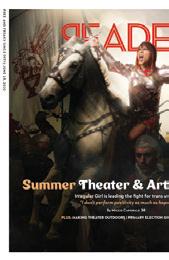










Write me a love letter My birthday is in September and I have decided I want love letters in all forms, from all sources, all around the city. Big or small, I welcome it all. So if you like the idea of fulfilling my cute little birthday wish. Don’t be shy, make a love note, and dedicate it to me, Wendy. And if you put it out in the world, let me know where to find it. whereiswndy@ gmail.com / www. whereiswndy.com
I’m fat, FTM (trans man), Mexican who is very shy and very introverted. NO TRANSPHOBES NEED APPLY, ESPECIALLY CIS STRAIGHT MEN. Must have Planet Fitness card. Text only 872-529-0333.



All romantic dates women wanted All romantic fun dates all requests 24.7 Call (773) 977-8862 swm










Hot Couple ISO Hot Singles! Hot Couple successful 55 yrs young with fit physiques, ISO Beautiful Uninhibited people to eXplore New Horizons. Lakefront, Sailing, Nude Sunbathing, Biking. Intrigue us with a hot reply!












Two Males, 58 and 60, Seek Sexy Lady 45-65 for Sensual Fun We are two friends who would love to please a woman together. We love lots of touching and oral!

MWM DOM SEEKS


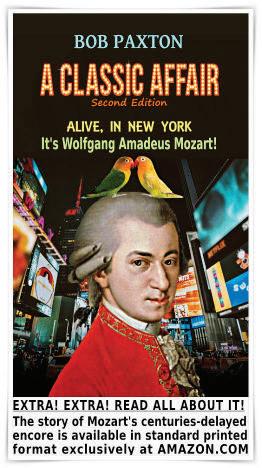
SUBMISSIVE FEMALE MWM DOM 52 SEEKS SUBMISSIVE FEMALE AND WILL TRAIN PLEASURE AND PUNISHMENT BONDAGE SPANKING ORAL CAN HOST CALL/ TEXT-224-292-9899.
MJM DOM SEEKS SUBMISSIVE JEWISH FEMALE MJM DOM 52 SEEKS SUBMISSIVE JEWISH FEMALE WILL TRAIN BONDAGE ORAL SPANKING PLEASURE AND PUNISHMENT CAN HOST CALL/ TEXT-224-292-9899.



FTM4M, 35 Seeks M4M Gym Partner Hi, I’m looking for a gym partner to spot with, and to be safe in the gym with while working out. NOT LOOKING FOR A HOOKUP.
Danielle’s Lip Service, Erotic Phone Chat. 24/7. Must be










Kick off Harris Theater’s 20th Anniversary with a day of free programming for all ages in Millennium Park featuring 20+ local music and dance companies!







Ballet Chicago
Ballet 5:8
Boys and Girls Club
Chicago Dancemakers Forum

Chicago Gay Men’s Chorus
Chicago High School for the Arts
Chicago Human Rhythm Project
Chicago Latin Orchestra
Chicago Opera Theater
Chicago Philharmonic




Fulcrum Point New Music Project

Giordano Dance Chicago
High Concept Labs
Hubbard Street Dance Chicago
Lucky Plush Productions
Muntu Dance Theatre
Music of the Baroque

Music Institute of Chicago
Sleeping At Last
South Chicago Dance Theatre
Uniting Voices Chicago
Photo courtesy of the City of Chicago, DCASE.